Ian Jarvis's Blog, page 2
January 31, 2021
NETHERWOOD - A BEASTLY NIGHT IN HASTINGS
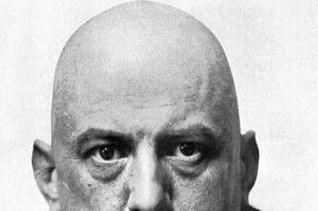
Aleister Crowley, the Great Beast 666 and self-proclaimed ‘wickedest man in the world’.
Whenever most people picture this notorious British occultist, it’s always with a shaven head, prompted by that famous and somewhat unsettling picture of him staring into the camera. Difficult as it is for many to imagine, he didn’t look like this from childhood to the grave. In reality, for the majority of his life he was quite attractive and debonair.

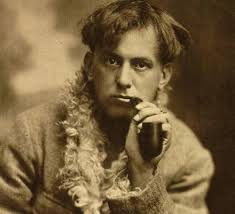
My latest Bernie Quist novel, the Rumba of the Beast, begins with Crowley in his final days in Hastings. The infamous magician died there aged 72 on the 1st of December 1947.
Or did he? My story suggests a series of very different events that took place on that fateful night, but the official (and, let’s face it, probably genuine) version follows…
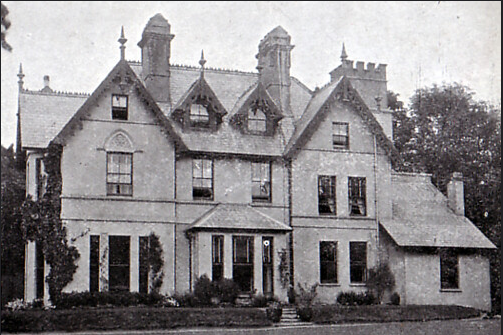
Crowley spent his final years at Netherwood, a large Victorian retirement home owned by Kathleen and Vernon Symonds. The property stood some 500 feet above the coastal town of Hastings, three miles from the centre on a suburban road named ‘the Ridge’.
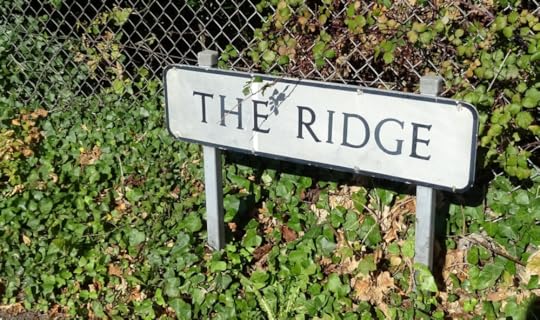
Extensive 4-acre grounds contained a tennis court, a large garden, shrubbery and many mature trees. Netherwood’s lofty position afforded extensive views of the town, its Norman castle, the ocean and Beachy Head, cliffs that Crowley had climbed in his younger mountaineering days.
Vernon Symonds was a friendly ‘arty type’ and his house was filled with poets, painters and musicians. This socialist commune provided a very relaxed atmosphere and the best cuisine possible in that difficult rationing period after the war.
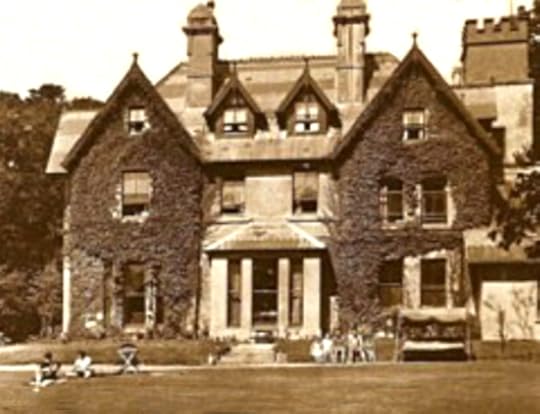
Crowley was finding it difficult to find somewhere to live at the time, but it shouldn’t have come as a surprise to him. His disreputable life had been filled with sex and drug experimentation, the summoning up of demons in rituals, and shagging women on altars. Most normal folk would probably have attempted to keep all this quiet, but he revelled in broadcasting his exploits. Worried about him, his old friend Louis Wilkinson, had heard about Netherwood and its eccentric proprietors and arranged for him to move there.

Kathleen Symonds couldn’t remember the exact day of Crowley’s arrival. The relevant page was torn out of the Netherwood guest book - presumably by someone stealing his signature – but the next date was the 8th of September 1945, suggesting he came to stay in late August or early September, six weeks before his 70th birthday. Kathleen recalled, Crowley looked pale and wan, and his hair was cut short. He wore wide knickerbockers with stockings, and shoes with big silver buckles. There was a choice of rooms, but Crowley insisted upon number 13, at the front of the house.
“He wanted that one,” said Kathleen. “It was furnished in the same way as most of the other rooms. There was a large wardrobe, a writing table, a bookshelf and a single bed, as well as a bathroom and toilet. He put up lots of pictures, including several he’d painted in the Himalayas.”

The Great Beast 666 soon settled into a regular routine. At nine each morning the housekeeper Miss Clarke (who didn’t like him) took him his breakfast, and at ten, if the weather was fine, he’d stroll in the garden. Kathleen kept beautiful white rabbits there, which he nicknamed ‘The Chrysanthemums’ and he loved to watch them. Crowley then spent the rest of the day sleeping in his room, where he also took his other meals. His favourite snack was sardines sprinkled with curry powder.
He roused himself as darkness fell, and sat up all night either writing letters, reading or taking illegal drugs. He had a very strong pipe tobacco made with molasses and the smell stayed in the room a long time after he was gone. He also made friends with a grocer named Mr Watson, who took him out for drives and would come and look after him.
“He had a ration of heroin which was allowed him,” said Kathleen Symonds. “It used to come from a chemist called Heppel’s in London. The police knew about it and I often watched him sticking needles in his arm. He didn’t mind.”
Despite (or possibly because of) his notorious reputation and the fact that he insisted on greeting everyone with: “Do what thou wilt shall be the whole of the law”, the Great Beast proved a popular addition to Netherwood. He had considerable charm, a pleasing personality and was very erudite, which helped make him a good companion and a stimulating talker. He had many long conversations with Vernon Symonds and he joined the Hastings Chess Club, where he claimed “nobody ever beat him”. He went for walks along The Ridge, where on sunny days he’d often stop and hold his hands palms upwards to the sun in a yoga pose, and he sometimes visited a Hastings health hydro named Riposo. There were rumours of him visiting the ballroom on Hastings pier where, although he was too old to indulge, he’d watch the young ladies dancing.
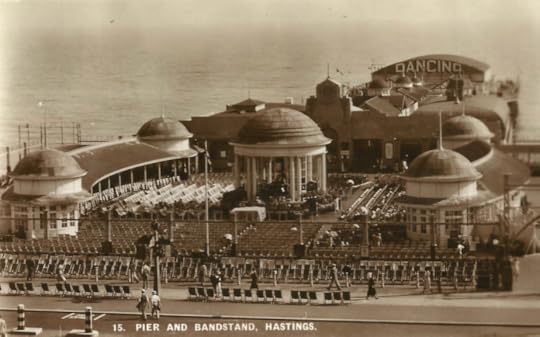
Crowley’s regular visitors included Louis Wilkinson, Kenneth Grant, author of Aleister Crowley and the Hidden God, Michael Houghton, the owner of the Atlantis Bookshop, and John Symonds, who wrote The Magic of Aleister Crowley. I love the fact that, shortly before his death, Kathleen recalled he was thinking of going to see the Wizard of Oz at the cinema, but this never happened.
Crowley’s health began to deteriorate with bronchitis towards the end of 1947 and he died of pneumonia on Monday, 1 December aged 72. He was driven to Brighton and cremated the following Friday where only a few mourners turned up. An unknown German lady placed red roses on his coffin, Louis Wilkinson read Crowley’s poem Hymn to Pan, and that night there was a tremendous thunderstorm over Hastings.
That’s the true story… or is it? The Rumba of the Beast provides an alternative, and slightly more dramatic, ending to Aleister Crowley's life.
Like Crowley, the Netherwood guest house and gardens are long gone. Most of the building was demolished in the mid-1970s to build the Wimpey development named Netherwood Close, but the east wing was saved and turned into a pub called the Robert De Mortain.
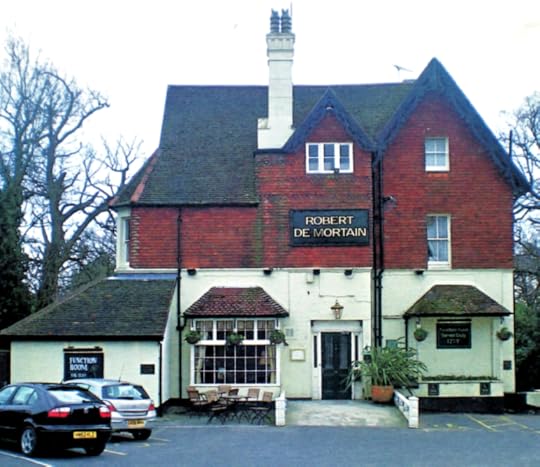
The 1987 hurricane tore off the pub roof, something which a local witchcraft coven claimed was down to Crowley’s spirit, but in reality was down to the hurricane. In 2017 the pub finally closed and it was pulled down the following year.
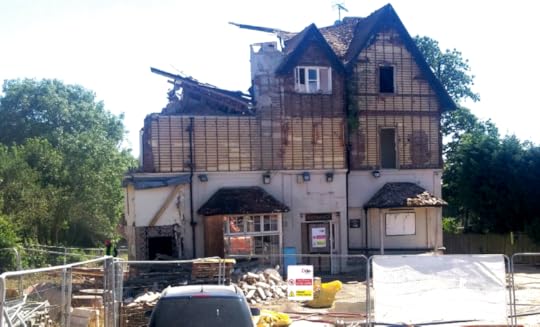
Robert De Mortain Place now stands on the site of Crowley's final home, a cul-de-sac of ten luxury houses.

The only remaining part of the original Netherwood complex is the old Coach House which still stands on Netherwood Close.
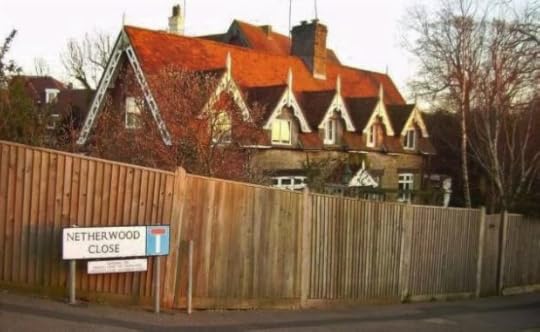
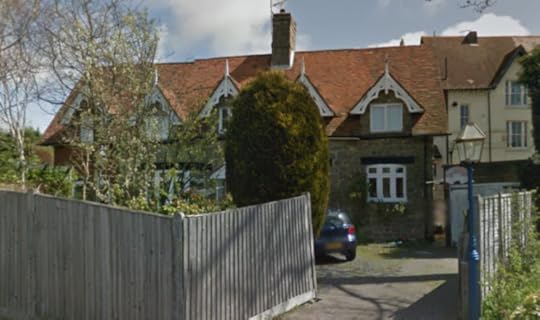
Crowley isn’t forgotten in Hastings. For a long while after his death his ghost haunted the pavement outside the Robert De Mortain pub, Netherwood Close and a section of the Ridge. Strangely, whenever it was spotted, the witnesses always described it as completely bald and staring, almost as if they'd seen the aforementioned photo of the shaven-headed Crowley and not the spirit of the elderly gentleman who died there.
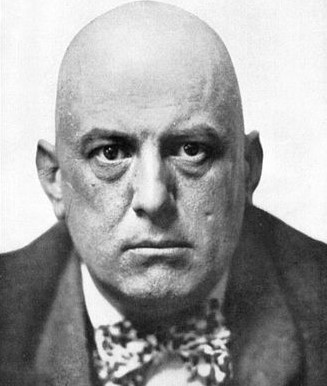
In more recent years this bald, staring ghost has moved three miles downhill to the rather good Crowley’s Bar in the town centre, where it’s often seen lurking in the gent’s toilets or sitting in a quiet corner.
The pub has more than a hint of a 666 theme. You can call in for a bag of Thelema crisps and a pint of Great Beast IPA for only £6.66, so "drink what thou wilt shall be the whole of the law". I’m sure Aleister would have approved.
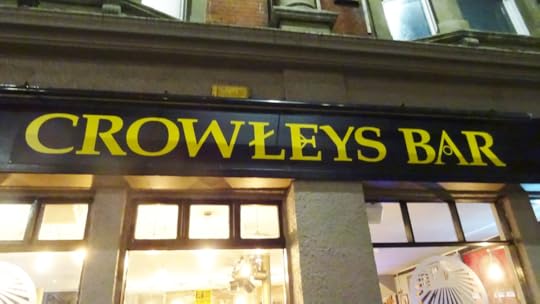
There’s a rumour that the Great Beast's spirit performed an occult ritual to make the apostrophe in the sign vanish. Either that, or the 'professional' sign artist they employed was a bit crap.
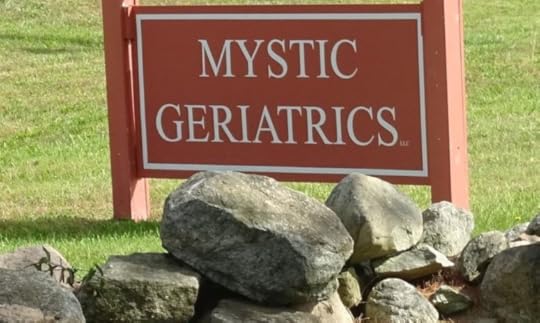
I always thought this place would have been a great rest home for Aleister Crowley in his twilight years. The current residents include Gandalf, Saruman and Merlin.
The Rumba of the Beast will be out later this year.
September 4, 2019
IF YOU WANT TO GET A HEAD...
 Writing the Bernie Quist series of detective mysteries has involved plenty of reading about werewolf legends, but one story that required little research was the strange Hexham story from the 1970s. I remember this being covered by the Nationwide television show, a popular factual programme back then, and I still recall the bizarre details. which I found quite unnerving as a teenager
Writing the Bernie Quist series of detective mysteries has involved plenty of reading about werewolf legends, but one story that required little research was the strange Hexham story from the 1970s. I remember this being covered by the Nationwide television show, a popular factual programme back then, and I still recall the bizarre details. which I found quite unnerving as a teenager I recently tracked down and photographed the house involved in the story.Steeped in history, the town of Hexham lies in Northumberland, just a couple of miles south of Hadrian's Wall. In 1971, Colin and Leslie Robson were digging in their garden at number 3, Rede Avenue, and discovered two carved stone heads. Living where they did, the Robsons believed their finds were Roman, or possibly even older.Unfortunately for the Robsons, bizarre and terrifying things then began to happen.
I recently tracked down and photographed the house involved in the story.Steeped in history, the town of Hexham lies in Northumberland, just a couple of miles south of Hadrian's Wall. In 1971, Colin and Leslie Robson were digging in their garden at number 3, Rede Avenue, and discovered two carved stone heads. Living where they did, the Robsons believed their finds were Roman, or possibly even older.Unfortunately for the Robsons, bizarre and terrifying things then began to happen.
 As the story goes: "They perceived a change in the environment of the place. It was an indescribable feeling of disturbance, as if something very bad was happening. Objects suddenly rushed to the ground, with no one responsible for moving them - shelves simply seemed to reject vases, portraits and books. A phone was constantly threatening to fall to the ground until the cable was torn off the wall. A lock broke in two after the door slammed hard. The walls began to crack and the pictures to twist. One night, the Robsons woke to the sound of a crashing glass, for no apparent reason the living room window had simply exploded, throwing splinters everywhere. Even more strange was the fact that at the exact site where the stone heads were found, all kinds of harmful grass and spiny ivy began to grow and insect pests devastated the garden. But the most annoying thing was a constant stench, a smell of wild animal urine that permeated every corner of the house."
As the story goes: "They perceived a change in the environment of the place. It was an indescribable feeling of disturbance, as if something very bad was happening. Objects suddenly rushed to the ground, with no one responsible for moving them - shelves simply seemed to reject vases, portraits and books. A phone was constantly threatening to fall to the ground until the cable was torn off the wall. A lock broke in two after the door slammed hard. The walls began to crack and the pictures to twist. One night, the Robsons woke to the sound of a crashing glass, for no apparent reason the living room window had simply exploded, throwing splinters everywhere. Even more strange was the fact that at the exact site where the stone heads were found, all kinds of harmful grass and spiny ivy began to grow and insect pests devastated the garden. But the most annoying thing was a constant stench, a smell of wild animal urine that permeated every corner of the house." The neighbour Ellen Dodd was also suffering weird phenomena. Her small son exhibited bite marks, as if "a large dog had savaged him", and there was a "wet dog" stink in the house. Ellen felt an "unseen presence" knock her to the ground and felt thick fur rubbing against her skin. Later, she and her daughter were up late when both witnessed a “half-man, half wolf” entering the bedroom. The pair screamed, but the creature seemed oblivious to them and left the room. They heard it “padding down the stairs on its hind legs”, and the front door was found wide open. They said it seemed like the creature was searching for something, and had left the house to continue elsewhere.
The neighbour Ellen Dodd was also suffering weird phenomena. Her small son exhibited bite marks, as if "a large dog had savaged him", and there was a "wet dog" stink in the house. Ellen felt an "unseen presence" knock her to the ground and felt thick fur rubbing against her skin. Later, she and her daughter were up late when both witnessed a “half-man, half wolf” entering the bedroom. The pair screamed, but the creature seemed oblivious to them and left the room. They heard it “padding down the stairs on its hind legs”, and the front door was found wide open. They said it seemed like the creature was searching for something, and had left the house to continue elsewhere. Interest in the local legend of the Wolf of Allendale was rekindled – a werewolf-type creature that plagued the Hexham area in 1904 - and the stone heads became associated with the possible re-appearance of the monster.The Robson children returned home from school one day to find the werewolf creature in their lounge. They raced out terrified and a group of men ran in to find nothing, save for the stink of the animal.The family had experienced enough and the heads were sent to Newcastle University, whilst a Catholic priest was brought in to bless the houses in Rede Avenue.
Interest in the local legend of the Wolf of Allendale was rekindled – a werewolf-type creature that plagued the Hexham area in 1904 - and the stone heads became associated with the possible re-appearance of the monster.The Robson children returned home from school one day to find the werewolf creature in their lounge. They raced out terrified and a group of men ran in to find nothing, save for the stink of the animal.The family had experienced enough and the heads were sent to Newcastle University, whilst a Catholic priest was brought in to bless the houses in Rede Avenue. Thought to be Celtic in origin, they were then given to the expert Doctor Anne Ross, as she had several others in her collection and wished to compare them.
Thought to be Celtic in origin, they were then given to the expert Doctor Anne Ross, as she had several others in her collection and wished to compare them.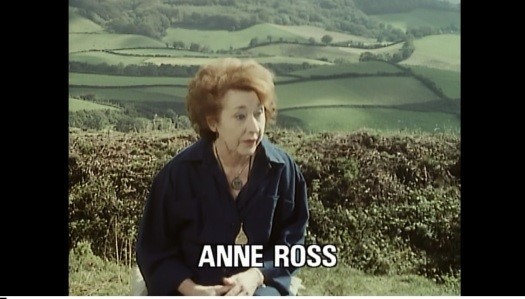
 She claimed she felt a strange coldness emanating from these two objects and, a few nights after taking possession, Dr Ross awoke at 2am one morning, feeling chilled and very frightened. Looking up, she saw a wolf creature standing in her bedroom doorway:
She claimed she felt a strange coldness emanating from these two objects and, a few nights after taking possession, Dr Ross awoke at 2am one morning, feeling chilled and very frightened. Looking up, she saw a wolf creature standing in her bedroom doorway: She said: “It was about six feet high, slightly stooping, and it was black, against the white door, and it was half animal and half man. The upper part was a wolf, and the lower part human. I would have said that it was covered with a kind of black, very dark fur. It went out and I just saw it clearly, and then it disappeared, and something made me run after it, a thing I wouldn’t normally have done, but I felt compelled to run after it. I got out of bed and I ran, and I could hear it going down the stairs, then it disappeared towards the back of the house.”Living in Southampton, Dr Ross knew nothing of the Allendale legend and the association of the Hexham Heads with the possible return of the werewolf.Later, Dr Ross came home with her archaeologist husband Richard to find their daughter Berenice in a distressed state. Berenice explained that she'd unlocked the front door and entered that afternoon to witness a large, black wolf rushing down the stairs; halfway down the creature vaulted the bannister, landing with a soft, heavy thud like a large animal with padded feet.
She said: “It was about six feet high, slightly stooping, and it was black, against the white door, and it was half animal and half man. The upper part was a wolf, and the lower part human. I would have said that it was covered with a kind of black, very dark fur. It went out and I just saw it clearly, and then it disappeared, and something made me run after it, a thing I wouldn’t normally have done, but I felt compelled to run after it. I got out of bed and I ran, and I could hear it going down the stairs, then it disappeared towards the back of the house.”Living in Southampton, Dr Ross knew nothing of the Allendale legend and the association of the Hexham Heads with the possible return of the werewolf.Later, Dr Ross came home with her archaeologist husband Richard to find their daughter Berenice in a distressed state. Berenice explained that she'd unlocked the front door and entered that afternoon to witness a large, black wolf rushing down the stairs; halfway down the creature vaulted the bannister, landing with a soft, heavy thud like a large animal with padded feet. The creature was seen several times more by other people in her house and, convinced the stone heads to be responsible for these horrific events, Dr Ross passed on her whole collection of heads, along with the Hexham pair to other collectors. The Hexham Heads soon found their way back to Newcastle University and were kept in their museum. Again, odd things happened there, but the werewolf was never spotted again.
The creature was seen several times more by other people in her house and, convinced the stone heads to be responsible for these horrific events, Dr Ross passed on her whole collection of heads, along with the Hexham pair to other collectors. The Hexham Heads soon found their way back to Newcastle University and were kept in their museum. Again, odd things happened there, but the werewolf was never spotted again.
 A truck driver named Desmond Craigie (above) then contacted the media in 1974 to say that he'd lived in the Rede Avenue house prior to the Robson family. Weirdly, he claimed he'd carved the heads himself in 1956 as a present for his daughter to play with and they'd become lost in the garden.Dr Ross didn't believe him and, frankly, this does seem even more bizarre than the werewolf stories.Just take another look at the heads and then try to imagine anyone (apart from perhaps Josef Fritzl) giving these to their little girl as playthings.
A truck driver named Desmond Craigie (above) then contacted the media in 1974 to say that he'd lived in the Rede Avenue house prior to the Robson family. Weirdly, he claimed he'd carved the heads himself in 1956 as a present for his daughter to play with and they'd become lost in the garden.Dr Ross didn't believe him and, frankly, this does seem even more bizarre than the werewolf stories.Just take another look at the heads and then try to imagine anyone (apart from perhaps Josef Fritzl) giving these to their little girl as playthings. Craigie attempted to make two more for the press to prove his story, but apparently they were nothing like the originals.The story ends, for now, in 1976 when the museum caught fire. After the blaze had been extinguished, the Hexham heads were found to be gone. No one has a clue where they are now.
Craigie attempted to make two more for the press to prove his story, but apparently they were nothing like the originals.The story ends, for now, in 1976 when the museum caught fire. After the blaze had been extinguished, the Hexham heads were found to be gone. No one has a clue where they are now.
April 22, 2019
CLAY THE 15th - JUDGMENT CLAY.
 Judgment Clay is released by MX Publishing on May the 15th, the latest in the series of humorous mysteries featuring York private investigator Bernie Quist.A modern-day Sherlock Holmes, the eccentric Quist operates as a consultant detective from an office on Baker Avenue in York. His assistant is Watson, although this Watson is a streetwise youth from the Grimpen council estate and he's definitely no doctor. The mismatched duo take on bizarre cases which invariably lead into the realms of the supernatural, a shadowy world that, thanks to his dark secret, Quist is all too familiar with.
Judgment Clay is released by MX Publishing on May the 15th, the latest in the series of humorous mysteries featuring York private investigator Bernie Quist.A modern-day Sherlock Holmes, the eccentric Quist operates as a consultant detective from an office on Baker Avenue in York. His assistant is Watson, although this Watson is a streetwise youth from the Grimpen council estate and he's definitely no doctor. The mismatched duo take on bizarre cases which invariably lead into the realms of the supernatural, a shadowy world that, thanks to his dark secret, Quist is all too familiar with. In Judgment Clay the north of England has a new political group headed by the charismatic Dominic Churchill. Popular with the tabloid press, the White Rose Party are outwardly similar to the Yorkshire Party and other regionalist organisations, campaigning for Yorkshire independence, fairer wages and pensions, and the adoption of Yorkshire Pudding as Britain’s national dish. Unfortunately, white is the appropriate word for this bunch, and their amiable façade conceals a far right group with a sinister racist agenda. Watson’s Jewish girlfriend has been attacked by Churchill’s paid thugs and Quist is determined to expose these white supremacists and end their rise to power.The detective soon realises that Churchill and his people have been targeted by someone else, a highly dangerous individual with a terrifying supernatural weapon. This man also plans to end White Rose, but his idea of ending is a touch more homicidal and gruesome.A dark and very peculiar game is afoot…
In Judgment Clay the north of England has a new political group headed by the charismatic Dominic Churchill. Popular with the tabloid press, the White Rose Party are outwardly similar to the Yorkshire Party and other regionalist organisations, campaigning for Yorkshire independence, fairer wages and pensions, and the adoption of Yorkshire Pudding as Britain’s national dish. Unfortunately, white is the appropriate word for this bunch, and their amiable façade conceals a far right group with a sinister racist agenda. Watson’s Jewish girlfriend has been attacked by Churchill’s paid thugs and Quist is determined to expose these white supremacists and end their rise to power.The detective soon realises that Churchill and his people have been targeted by someone else, a highly dangerous individual with a terrifying supernatural weapon. This man also plans to end White Rose, but his idea of ending is a touch more homicidal and gruesome.A dark and very peculiar game is afoot… As usual, the story is set in York, one of my favourite cities and a place which rivals Prague, Vienna, Krakow and Saltsburg for architectural beauty and medieval splendour. Every stroll through the cobbled streets and snickleways is a stroll through history, with each turn bringing you face-to-face with Elizabethan ramparts, Tudor buildings and ancient taverns.York is the perfect setting for these Quist supernatural mysteries and I’ve attempted to use it as an actual character, in the same way that the Morse and Rebus novels breathe life into Oxford and Edinburgh. The Shambles, the Minster and the circuit of walls are all visited in Judgment Clay, but there are many other places that local readers will know: the King’s Arms inn by the river, for example, and the York Dungeon chamber of horrors.
As usual, the story is set in York, one of my favourite cities and a place which rivals Prague, Vienna, Krakow and Saltsburg for architectural beauty and medieval splendour. Every stroll through the cobbled streets and snickleways is a stroll through history, with each turn bringing you face-to-face with Elizabethan ramparts, Tudor buildings and ancient taverns.York is the perfect setting for these Quist supernatural mysteries and I’ve attempted to use it as an actual character, in the same way that the Morse and Rebus novels breathe life into Oxford and Edinburgh. The Shambles, the Minster and the circuit of walls are all visited in Judgment Clay, but there are many other places that local readers will know: the King’s Arms inn by the river, for example, and the York Dungeon chamber of horrors. The little port of Whitby features prominently in Judgment Clay too, along with the coastal resort of Scarborough, where Quist has a peculiar meeting with a seafront clairvoyant and deals with a grisly murder in the Grand Hotel.
The little port of Whitby features prominently in Judgment Clay too, along with the coastal resort of Scarborough, where Quist has a peculiar meeting with a seafront clairvoyant and deals with a grisly murder in the Grand Hotel. The market town of Beverley is also visited and the mystery surrounding the legend of the Barmston Drain werewolf is finally solved, albeit solved with tongue firmly in cheek.
The market town of Beverley is also visited and the mystery surrounding the legend of the Barmston Drain werewolf is finally solved, albeit solved with tongue firmly in cheek. One of the main characters in Judgment Clay is a female firefighter based at the Kent Street station in York. I spent three decades with West Yorkshire Fire and Rescue, but this is the first time I’ve used my insider knowledge in a novel. Some of the incidents and officers described are based on real life episodes and people from my career and there are cynical looks at government spending cuts, brigade policies and some of the officers who slavishly obey these policies no matter what. Names and places have obviously been changed to, er, protect against litigation, but many fire service readers will laugh and nod knowingly.
One of the main characters in Judgment Clay is a female firefighter based at the Kent Street station in York. I spent three decades with West Yorkshire Fire and Rescue, but this is the first time I’ve used my insider knowledge in a novel. Some of the incidents and officers described are based on real life episodes and people from my career and there are cynical looks at government spending cuts, brigade policies and some of the officers who slavishly obey these policies no matter what. Names and places have obviously been changed to, er, protect against litigation, but many fire service readers will laugh and nod knowingly. I joined the fire service in January 1986, too late for the York Minster blaze of July 84, but that was a North Yorkshire fire and my station wouldn’t have been called. That night was very like the recent Notre Dame tragedy. I know people who were on duty and their stories of molten roof lead gushing down like lethal waterfalls never had me yearning to be there with them.
I joined the fire service in January 1986, too late for the York Minster blaze of July 84, but that was a North Yorkshire fire and my station wouldn’t have been called. That night was very like the recent Notre Dame tragedy. I know people who were on duty and their stories of molten roof lead gushing down like lethal waterfalls never had me yearning to be there with them. Judgment Clay is available for pre-order from Amazon, Waterstones and all other book outlets, including the Book Depository who currently have ten percent off and free delivery.https://www.bookdepository.com/Judgme... why not diary May the 15th and settle down with a paperback and a cold beer? Could there be a better way to spend a summer evening? Well, yes - playing naked Twister with a slightly drunk and giggly Eva Green, but let's be realistic here.
Judgment Clay is available for pre-order from Amazon, Waterstones and all other book outlets, including the Book Depository who currently have ten percent off and free delivery.https://www.bookdepository.com/Judgme... why not diary May the 15th and settle down with a paperback and a cold beer? Could there be a better way to spend a summer evening? Well, yes - playing naked Twister with a slightly drunk and giggly Eva Green, but let's be realistic here.
November 18, 2018
I SEE A TALL DARK STRANGER AND A BOOK - JUDGMENT CLAY
 Standing by the harbour in the pretty Yorkshire fishing port of Whitby you’ll find a wooden shack owned by a gypsy named Lee Ester Alita Lee. If you pay her, she’ll look at your hand and tell you all about your future. That’s right - she’s able to see things that have yet to happen.I’ve spoken to this lady many times and she’s very nice and friendly, but can she actually see things that will happen in the future? Science, logic and reason might say no, but various famous people seem to think she can, mostly cast members from those old northern television shows: Heartbeat and the Royal. She has photographs in her cabin showing actors from these programmes having their palms read and some appear astounded by her gift.‘You’re telling me they’re going to cancel my Heartbeat cash cow after running for eighteen years? Oh, shit!’.
Standing by the harbour in the pretty Yorkshire fishing port of Whitby you’ll find a wooden shack owned by a gypsy named Lee Ester Alita Lee. If you pay her, she’ll look at your hand and tell you all about your future. That’s right - she’s able to see things that have yet to happen.I’ve spoken to this lady many times and she’s very nice and friendly, but can she actually see things that will happen in the future? Science, logic and reason might say no, but various famous people seem to think she can, mostly cast members from those old northern television shows: Heartbeat and the Royal. She has photographs in her cabin showing actors from these programmes having their palms read and some appear astounded by her gift.‘You’re telling me they’re going to cancel my Heartbeat cash cow after running for eighteen years? Oh, shit!’. Back in 1990 a friend of mine started work with the British Antarctic Survey. One week before he flew to Uruguay to catch his ship down to the ice shelf, I was holidaying with him and a few others in Whitby and, at my insistence, he went for a reading in the famous white shack. The gypsy saw various scenarios in his future and cryptically told him: ‘You’ll never be rich, but you’ll never, ever be poor’, and ‘I see a young lady in the near future with a letter E in her name, or possibly a letter S’.The peculiar thing was, her psychic senses never picked up on the fact that this man’s next three years would be spent in constant snow and ice at the very bottom of the planet, building a base at the South Pole in temperatures of minus sixty-five.Lee Ester Alita Lee's psychic palm reading business features in the next Bernie Quist mystery Judgment Clay, where much of the story takes place in Whitby and the nearby town of Scarborough. Using poetic license (and to protect from litigation and gypsy curses) her name has been changed to Madame Selene and the shack has been moved to a slightly different location by the sea.
Back in 1990 a friend of mine started work with the British Antarctic Survey. One week before he flew to Uruguay to catch his ship down to the ice shelf, I was holidaying with him and a few others in Whitby and, at my insistence, he went for a reading in the famous white shack. The gypsy saw various scenarios in his future and cryptically told him: ‘You’ll never be rich, but you’ll never, ever be poor’, and ‘I see a young lady in the near future with a letter E in her name, or possibly a letter S’.The peculiar thing was, her psychic senses never picked up on the fact that this man’s next three years would be spent in constant snow and ice at the very bottom of the planet, building a base at the South Pole in temperatures of minus sixty-five.Lee Ester Alita Lee's psychic palm reading business features in the next Bernie Quist mystery Judgment Clay, where much of the story takes place in Whitby and the nearby town of Scarborough. Using poetic license (and to protect from litigation and gypsy curses) her name has been changed to Madame Selene and the shack has been moved to a slightly different location by the sea. Writing about this got me thinking. I don’t know if this gypsy lady can see into the future or not, but if she CAN, you have to wonder why she’s sitting in a seaside hut, squandering her incredible supernatural gift on giggling Yorkshire tourists. Instead, she could be working nationwide with the British police and the security services in an effort to pinpoint the next terror attacks.
Writing about this got me thinking. I don’t know if this gypsy lady can see into the future or not, but if she CAN, you have to wonder why she’s sitting in a seaside hut, squandering her incredible supernatural gift on giggling Yorkshire tourists. Instead, she could be working nationwide with the British police and the security services in an effort to pinpoint the next terror attacks. The authorities have ‘watch lists’ of suspects with photographs and information, all of which could be scrutinised with her powers and any future plots could hopefully be thwarted. The biggest hurdle would already have been crossed in that she’d have NAMES to work with.Psychics are traditionally poor with names. When spirits communicate with them, they only supply one or maybe two letters to identify themselves. The medium then passes these letters to the bereaved clients and they have to fill in the blanks…‘I have someone here with a letter N in their name.’‘Oh, er, right. My husband was called Matthew.’‘Wait a moment. It’s M, not N, and yes, it IS Matthew. Yes, Matthew is here and he wants to speak to you.’
The authorities have ‘watch lists’ of suspects with photographs and information, all of which could be scrutinised with her powers and any future plots could hopefully be thwarted. The biggest hurdle would already have been crossed in that she’d have NAMES to work with.Psychics are traditionally poor with names. When spirits communicate with them, they only supply one or maybe two letters to identify themselves. The medium then passes these letters to the bereaved clients and they have to fill in the blanks…‘I have someone here with a letter N in their name.’‘Oh, er, right. My husband was called Matthew.’‘Wait a moment. It’s M, not N, and yes, it IS Matthew. Yes, Matthew is here and he wants to speak to you.’ As I say, this isn't the fault of the mediums. For some weird reason, the spirits won’t give their identity outright, but instead, insist upon drip-feeding their name as letters in this cryptic fashion. Why on earth they do this has never been understood. If these spirits had no interest in word puzzles when they were alive, why do they start pissing about with them when they’re dead?
As I say, this isn't the fault of the mediums. For some weird reason, the spirits won’t give their identity outright, but instead, insist upon drip-feeding their name as letters in this cryptic fashion. Why on earth they do this has never been understood. If these spirits had no interest in word puzzles when they were alive, why do they start pissing about with them when they’re dead? This ‘one letter only’ game is usually when the medium is working face to face with a single bereaved client. Things are slightly different when they’re contacting the dead on stage with a hall full of people all hoping for a message. The spirits will then give their first name. They’ll say: ‘it’s David’, but although this seems fairly useless without a surname, various people will respond and raise their hands and the medium will pick one.‘It’s you. Yes, this is YOUR David.’If only the spirits would give a surname and mention who they wished to contact, it would be so much more helpful. How difficult would it be to say:‘This is David Jessops for Amy Jessops sitting at the front there in the blue coat.’'The lady I want to speak to is Janet Matthews in the fawn raincoat by the door'.This would save the medium having to vaguely indicate to half the auditorium, saying: ‘I have a John here for someone in this right half of the room, or possibly the left.’It’s extremely annoying and can make the medium look like a fake who’s just fishing.
This ‘one letter only’ game is usually when the medium is working face to face with a single bereaved client. Things are slightly different when they’re contacting the dead on stage with a hall full of people all hoping for a message. The spirits will then give their first name. They’ll say: ‘it’s David’, but although this seems fairly useless without a surname, various people will respond and raise their hands and the medium will pick one.‘It’s you. Yes, this is YOUR David.’If only the spirits would give a surname and mention who they wished to contact, it would be so much more helpful. How difficult would it be to say:‘This is David Jessops for Amy Jessops sitting at the front there in the blue coat.’'The lady I want to speak to is Janet Matthews in the fawn raincoat by the door'.This would save the medium having to vaguely indicate to half the auditorium, saying: ‘I have a John here for someone in this right half of the room, or possibly the left.’It’s extremely annoying and can make the medium look like a fake who’s just fishing. Once this initial name hurdle is over, the spirits start chatting and the nonsense with the letter game never reappears. They’ll make vague references to pets, a favourite song, and a faulty vehicle or household appliance. The medium always sees someone in a uniform too. It’s pointless asking what kind of uniform it is, as this will cause the vision to become indistinct, and the best practise is for the bereaved relatives to keep things flowing by assisting the medium and telling them what uniform it is…‘Uniform? Oh, that’ll be our Terry. He was once in the army’.‘Uniform? Uniform? I don’t think I know… Oh, it must be our Shirley. She wears a kind of uniform in the supermarket where she works.’The main thing is, once the spirits are over the initial name hurdle, everything seems to flow just fine…‘He’s telling me how he loved his holidays on the coast. Where was it again?’‘Blackpool.’‘That’s right, Blackpool. He says you both loved it there, but oooh, do you remember that time it rained and how wet you both got? And he did like his fish and chips, didn’t he? He’s telling me how he always asked for scraps and told them to put plenty of salt and vinegar on. You remember that, don’t you? He says you had a favourite song that always reminded you both of Blackpool. He’s saying it was… It was…’‘Smile, by Lily Allen.’‘That’s right, Smile. And he’s saying that’s what you should always do when you hear it. You should smile and think of him.’
Once this initial name hurdle is over, the spirits start chatting and the nonsense with the letter game never reappears. They’ll make vague references to pets, a favourite song, and a faulty vehicle or household appliance. The medium always sees someone in a uniform too. It’s pointless asking what kind of uniform it is, as this will cause the vision to become indistinct, and the best practise is for the bereaved relatives to keep things flowing by assisting the medium and telling them what uniform it is…‘Uniform? Oh, that’ll be our Terry. He was once in the army’.‘Uniform? Uniform? I don’t think I know… Oh, it must be our Shirley. She wears a kind of uniform in the supermarket where she works.’The main thing is, once the spirits are over the initial name hurdle, everything seems to flow just fine…‘He’s telling me how he loved his holidays on the coast. Where was it again?’‘Blackpool.’‘That’s right, Blackpool. He says you both loved it there, but oooh, do you remember that time it rained and how wet you both got? And he did like his fish and chips, didn’t he? He’s telling me how he always asked for scraps and told them to put plenty of salt and vinegar on. You remember that, don’t you? He says you had a favourite song that always reminded you both of Blackpool. He’s saying it was… It was…’‘Smile, by Lily Allen.’‘That’s right, Smile. And he’s saying that’s what you should always do when you hear it. You should smile and think of him.’ Once the spirits start, it’s difficult to shut them up, but first they need to start and overcome that initial fumbling business with their name.This wouldn’t be a problem with the police watch list of names and Lee Ester Alita Lee could concentrate on them and get on with sensing their future and whatever terrorism shenanigans they were about to get up to.Now if this woman (and other mediums like her) CAN see the future, we could make Britain a far safer place by having her work with MI5. If she CAN’T, then why is she allowed to take money by openly operating a fraudulent service?She’s been trading in Whitby for decades and has never once been questioned by the trading standards people as to her blatantly advertised supernatural claims.If I were to set up a stall next door selling cures for cancer (£25 a bottle. It looks like water, it tastes like water, but if you have faith when you drink it, your illness will vanish) I wonder how many days (or even hours) I’d be trading before the authorities closed me down and, very probably, prosecuted me.I doubt it would do much good to point out that the woman next door was making a fortune from an equally bizarre enterprise with similar bizarre claims.Who knows?To finish, here's a young lady finding out how wonderful her future will be from a medium who's been trading on the seafront for a great many years...
Once the spirits start, it’s difficult to shut them up, but first they need to start and overcome that initial fumbling business with their name.This wouldn’t be a problem with the police watch list of names and Lee Ester Alita Lee could concentrate on them and get on with sensing their future and whatever terrorism shenanigans they were about to get up to.Now if this woman (and other mediums like her) CAN see the future, we could make Britain a far safer place by having her work with MI5. If she CAN’T, then why is she allowed to take money by openly operating a fraudulent service?She’s been trading in Whitby for decades and has never once been questioned by the trading standards people as to her blatantly advertised supernatural claims.If I were to set up a stall next door selling cures for cancer (£25 a bottle. It looks like water, it tastes like water, but if you have faith when you drink it, your illness will vanish) I wonder how many days (or even hours) I’d be trading before the authorities closed me down and, very probably, prosecuted me.I doubt it would do much good to point out that the woman next door was making a fortune from an equally bizarre enterprise with similar bizarre claims.Who knows?To finish, here's a young lady finding out how wonderful her future will be from a medium who's been trading on the seafront for a great many years...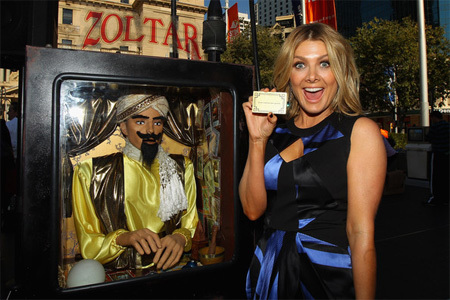
I SEE A TALL DARK STRANGER AND A BOOK - JUDGEMENT CLAY
 Standing by the harbour in the pretty Yorkshire fishing port of Whitby you’ll find a wooden shack owned by a gypsy named Lee Ester Alita Lee. If you pay her, she’ll look at your hand and tell you all about your future. That’s right - she’s able to see things that have yet to happen.I’ve spoken to this lady many times and she’s very nice and friendly, but can she actually see things that will happen in the future? Science, logic and reason might say no, but various famous people seem to think she can, mostly cast members from those old northern television shows: Heartbeat and the Royal. She has photographs in her cabin showing actors from these programmes having their palms read and some appear astounded by her gift.‘You’re telling me they’re going to cancel my Heartbeat cash cow after running for eighteen years? Oh, shit!’.
Standing by the harbour in the pretty Yorkshire fishing port of Whitby you’ll find a wooden shack owned by a gypsy named Lee Ester Alita Lee. If you pay her, she’ll look at your hand and tell you all about your future. That’s right - she’s able to see things that have yet to happen.I’ve spoken to this lady many times and she’s very nice and friendly, but can she actually see things that will happen in the future? Science, logic and reason might say no, but various famous people seem to think she can, mostly cast members from those old northern television shows: Heartbeat and the Royal. She has photographs in her cabin showing actors from these programmes having their palms read and some appear astounded by her gift.‘You’re telling me they’re going to cancel my Heartbeat cash cow after running for eighteen years? Oh, shit!’. Back in 1990 a friend of mine started work with the British Antarctic Survey. One week before he flew to Uruguay to catch his ship down to the ice shelf, I was holidaying with him and a few others in Whitby and, at my insistence, he went for a reading in the famous white shack. The gypsy saw various scenarios in his future and cryptically told him: ‘You’ll never be rich, but you’ll never, ever be poor’, and ‘I see a young lady in the near future with a letter E in her name, or possibly a letter S’.The peculiar thing was, her psychic senses never picked up on the fact that this man’s next three years would be spent in constant snow and ice at the very bottom of the planet, building a base at the South Pole in temperatures of minus sixty-five.Lee Ester Alita Lee's psychic palm reading business features in the next Bernie Quist mystery Judgement Clay, where much of the story takes place in Whitby and the nearby town of Scarborough. Using poetic license (and to protect from litigation and gypsy curses) her name has been changed to Madame Selene and the shack has been moved to a slightly different location by the sea.
Back in 1990 a friend of mine started work with the British Antarctic Survey. One week before he flew to Uruguay to catch his ship down to the ice shelf, I was holidaying with him and a few others in Whitby and, at my insistence, he went for a reading in the famous white shack. The gypsy saw various scenarios in his future and cryptically told him: ‘You’ll never be rich, but you’ll never, ever be poor’, and ‘I see a young lady in the near future with a letter E in her name, or possibly a letter S’.The peculiar thing was, her psychic senses never picked up on the fact that this man’s next three years would be spent in constant snow and ice at the very bottom of the planet, building a base at the South Pole in temperatures of minus sixty-five.Lee Ester Alita Lee's psychic palm reading business features in the next Bernie Quist mystery Judgement Clay, where much of the story takes place in Whitby and the nearby town of Scarborough. Using poetic license (and to protect from litigation and gypsy curses) her name has been changed to Madame Selene and the shack has been moved to a slightly different location by the sea. Writing about this got me thinking. I don’t know if this gypsy lady can see into the future or not, but if she CAN, you have to wonder why she’s sitting in a seaside hut, squandering her incredible supernatural gift on giggling Yorkshire tourists. Instead, she could be working nationwide with the British police and the security services in an effort to pinpoint the next terror attacks.
Writing about this got me thinking. I don’t know if this gypsy lady can see into the future or not, but if she CAN, you have to wonder why she’s sitting in a seaside hut, squandering her incredible supernatural gift on giggling Yorkshire tourists. Instead, she could be working nationwide with the British police and the security services in an effort to pinpoint the next terror attacks. The authorities have ‘watch lists’ of suspects with photographs and information, all of which could be scrutinised with her powers and any future plots could hopefully be thwarted. The biggest hurdle would already have been crossed in that she’d have NAMES to work with.Psychics are traditionally poor with names. When spirits communicate with them, they only supply one or maybe two letters to identify themselves. The medium then passes these letters to the bereaved clients and they have to fill in the blanks…‘I have someone here with a letter N in their name.’‘Oh, er, right. My husband was called Matthew.’‘Wait a moment. It’s M, not N, and yes, it IS Matthew. Yes, Matthew is here and he wants to speak to you.’
The authorities have ‘watch lists’ of suspects with photographs and information, all of which could be scrutinised with her powers and any future plots could hopefully be thwarted. The biggest hurdle would already have been crossed in that she’d have NAMES to work with.Psychics are traditionally poor with names. When spirits communicate with them, they only supply one or maybe two letters to identify themselves. The medium then passes these letters to the bereaved clients and they have to fill in the blanks…‘I have someone here with a letter N in their name.’‘Oh, er, right. My husband was called Matthew.’‘Wait a moment. It’s M, not N, and yes, it IS Matthew. Yes, Matthew is here and he wants to speak to you.’ As I say, this isn't the fault of the mediums. For some weird reason, the spirits won’t give their identity outright, but instead, insist upon drip-feeding their name as letters in this cryptic fashion. Why on earth they do this has never been understood. If these spirits had no interest in word puzzles when they were alive, why do they start pissing about with them when they’re dead?
As I say, this isn't the fault of the mediums. For some weird reason, the spirits won’t give their identity outright, but instead, insist upon drip-feeding their name as letters in this cryptic fashion. Why on earth they do this has never been understood. If these spirits had no interest in word puzzles when they were alive, why do they start pissing about with them when they’re dead? This ‘one letter only’ game is usually when the medium is working face to face with a single bereaved client. Things are slightly different when they’re contacting the dead on stage with a hall full of people all hoping for a message. The spirits will then give their first name. They’ll say: ‘it’s David’, but although this seems fairly useless without a surname, various people will respond and raise their hands and the medium will pick one.‘It’s you. Yes, this is YOUR David.’If only the spirits would give a surname and mention who they wished to contact, it would be so much more helpful. How difficult would it be to say:‘This is David Jessops for Amy Jessops sitting at the front there in the blue coat.’'The lady I want to speak to is Janet Matthews in the fawn raincoat by the door'.This would save the medium having to vaguely indicate to half the auditorium, saying: ‘I have a John here for someone in this right half of the room, or possibly the left.’It’s extremely annoying and can make the medium look like a fake who’s just fishing.
This ‘one letter only’ game is usually when the medium is working face to face with a single bereaved client. Things are slightly different when they’re contacting the dead on stage with a hall full of people all hoping for a message. The spirits will then give their first name. They’ll say: ‘it’s David’, but although this seems fairly useless without a surname, various people will respond and raise their hands and the medium will pick one.‘It’s you. Yes, this is YOUR David.’If only the spirits would give a surname and mention who they wished to contact, it would be so much more helpful. How difficult would it be to say:‘This is David Jessops for Amy Jessops sitting at the front there in the blue coat.’'The lady I want to speak to is Janet Matthews in the fawn raincoat by the door'.This would save the medium having to vaguely indicate to half the auditorium, saying: ‘I have a John here for someone in this right half of the room, or possibly the left.’It’s extremely annoying and can make the medium look like a fake who’s just fishing. Once this initial name hurdle is over, the spirits start chatting and the nonsense with the letter game never reappears. They’ll make vague references to pets, a favourite song, and a faulty vehicle or household appliance. The medium always sees someone in a uniform too. It’s pointless asking what kind of uniform it is, as this will cause the vision to become indistinct, and the best practise is for the bereaved relatives to keep things flowing by assisting the medium and telling them what uniform it is…‘Uniform? Oh, that’ll be our Terry. He was once in the army’.‘Uniform? Uniform? I don’t think I know… Oh, it must be our Shirley. She wears a kind of uniform in the supermarket where she works.’The main thing is, once the spirits are over the initial name hurdle, everything seems to flow just fine…‘He’s telling me how he loved his holidays on the coast. Where was it again?’‘Blackpool.’‘That’s right, Blackpool. He says you both loved it there, but oooh, do you remember that time it rained and how wet you both got? And he did like his fish and chips, didn’t he? He’s telling me how he always asked for scraps and told them to put plenty of salt and vinegar on. You remember that, don’t you? He says you had a favourite song that always reminded you both of Blackpool. He’s saying it was… It was…’‘Smile, by Lily Allen.’‘That’s right, Smile. And he’s saying that’s what you should always do when you hear it. You should smile and think of him.’
Once this initial name hurdle is over, the spirits start chatting and the nonsense with the letter game never reappears. They’ll make vague references to pets, a favourite song, and a faulty vehicle or household appliance. The medium always sees someone in a uniform too. It’s pointless asking what kind of uniform it is, as this will cause the vision to become indistinct, and the best practise is for the bereaved relatives to keep things flowing by assisting the medium and telling them what uniform it is…‘Uniform? Oh, that’ll be our Terry. He was once in the army’.‘Uniform? Uniform? I don’t think I know… Oh, it must be our Shirley. She wears a kind of uniform in the supermarket where she works.’The main thing is, once the spirits are over the initial name hurdle, everything seems to flow just fine…‘He’s telling me how he loved his holidays on the coast. Where was it again?’‘Blackpool.’‘That’s right, Blackpool. He says you both loved it there, but oooh, do you remember that time it rained and how wet you both got? And he did like his fish and chips, didn’t he? He’s telling me how he always asked for scraps and told them to put plenty of salt and vinegar on. You remember that, don’t you? He says you had a favourite song that always reminded you both of Blackpool. He’s saying it was… It was…’‘Smile, by Lily Allen.’‘That’s right, Smile. And he’s saying that’s what you should always do when you hear it. You should smile and think of him.’ Once the spirits start, it’s difficult to shut them up, but first they need to start and overcome that initial fumbling business with their name.This wouldn’t be a problem with the police watch list of names and Lee Ester Alita Lee could concentrate on them and get on with sensing their future and whatever terrorism shenanigans they were about to get up to.Now if this woman (and other mediums like her) CAN see the future, we could make Britain a far safer place by having her work with MI5. If she CAN’T, then why is she allowed to take money by openly operating a fraudulent service?She’s been trading in Whitby for decades and has never once been questioned by the trading standards people as to her blatantly advertised supernatural claims.If I were to set up a stall next door selling cures for cancer (£25 a bottle. It looks like water, it tastes like water, but if you have faith when you drink it, your illness will vanish) I wonder how many days (or even hours) I’d be trading before the authorities closed me down and, very probably, prosecuted me.I doubt it would do much good to point out that the woman next door was making a fortune from an equally bizarre enterprise with similar bizarre claims.Who knows?To finish, here's a young lady finding out how wonderful her future will be from a medium who's been trading on the seafront for a great many years...
Once the spirits start, it’s difficult to shut them up, but first they need to start and overcome that initial fumbling business with their name.This wouldn’t be a problem with the police watch list of names and Lee Ester Alita Lee could concentrate on them and get on with sensing their future and whatever terrorism shenanigans they were about to get up to.Now if this woman (and other mediums like her) CAN see the future, we could make Britain a far safer place by having her work with MI5. If she CAN’T, then why is she allowed to take money by openly operating a fraudulent service?She’s been trading in Whitby for decades and has never once been questioned by the trading standards people as to her blatantly advertised supernatural claims.If I were to set up a stall next door selling cures for cancer (£25 a bottle. It looks like water, it tastes like water, but if you have faith when you drink it, your illness will vanish) I wonder how many days (or even hours) I’d be trading before the authorities closed me down and, very probably, prosecuted me.I doubt it would do much good to point out that the woman next door was making a fortune from an equally bizarre enterprise with similar bizarre claims.Who knows?To finish, here's a young lady finding out how wonderful her future will be from a medium who's been trading on the seafront for a great many years...
July 19, 2018
GENERALLY SPEAKING...
 A pictorial visit to the Suffolk locations used in Witchfinder General and a look at Matthew Hopkins himself.Witchfinder General. The 1968 folk horror film by the young director Michael Reeves was renamed the Conqueror Worm in the USA in a mercenary attempt to cash in on the Vincent Price / Edgar Allan Poe series of 1960s films. Conqueror Worm was a poem about death by Poe and, although the title made no sense and had absolutely no bearing on the film whatsoever, this is what they decided upon. The Conqueror Worm - who pays these people and how much?
A pictorial visit to the Suffolk locations used in Witchfinder General and a look at Matthew Hopkins himself.Witchfinder General. The 1968 folk horror film by the young director Michael Reeves was renamed the Conqueror Worm in the USA in a mercenary attempt to cash in on the Vincent Price / Edgar Allan Poe series of 1960s films. Conqueror Worm was a poem about death by Poe and, although the title made no sense and had absolutely no bearing on the film whatsoever, this is what they decided upon. The Conqueror Worm - who pays these people and how much?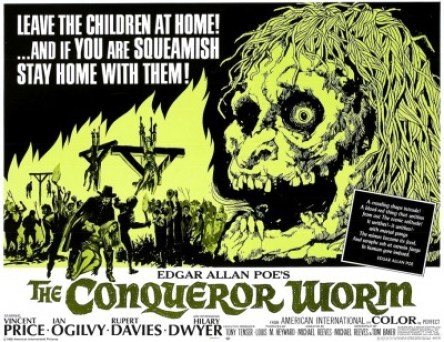 Matthew Hopkins, East Anglia’s most notorious serial killer, was born around 1620 in Great Wenham, Suffolk. In the name of his benevolent God (and for a substantial amount of cash), he hung over 300 innocent women and some men during the turmoil of the English Civil War. This was far more than all the other witch killers combined of the past century. Although his torturing and killing was never officially endorsed by the church, noticeably little was ever done to stop or hinder him.
Matthew Hopkins, East Anglia’s most notorious serial killer, was born around 1620 in Great Wenham, Suffolk. In the name of his benevolent God (and for a substantial amount of cash), he hung over 300 innocent women and some men during the turmoil of the English Civil War. This was far more than all the other witch killers combined of the past century. Although his torturing and killing was never officially endorsed by the church, noticeably little was ever done to stop or hinder him.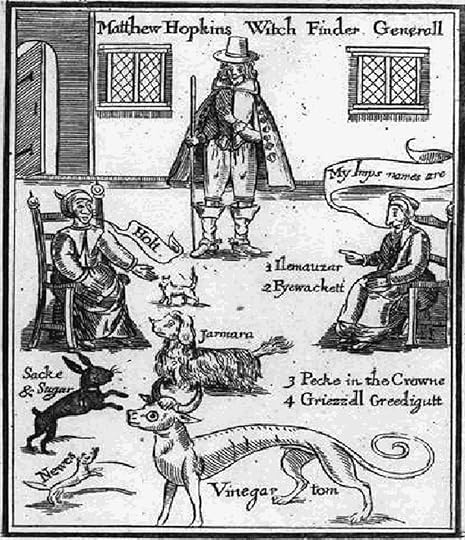
 In the early 1640s, Hopkins used inheritance money to buy the Thorn Inn in the village of Mistley, where many of his witch trials were held. The present inn was built in 1723 on the foundations and cellars of this.
In the early 1640s, Hopkins used inheritance money to buy the Thorn Inn in the village of Mistley, where many of his witch trials were held. The present inn was built in 1723 on the foundations and cellars of this. A plaque on the wall tells of the atrocities carried out there, and they do a selection of very nice bar meals and local ales.Whenever people think of Hopkins, they usually picture Vincent Price, star of the 1968 film. This is understandable as, apart from a few ancient woodcut prints (see above), which may as well have been drawn by a six-year-old, this mature, grey-haired look is the only image we have to go on. The ludicrous title Hopkins gave himself also fools us into thinking of an older man; General is a high rank and the holders, such as Eisenhower and Patton, are inevitably getting on a bit.
A plaque on the wall tells of the atrocities carried out there, and they do a selection of very nice bar meals and local ales.Whenever people think of Hopkins, they usually picture Vincent Price, star of the 1968 film. This is understandable as, apart from a few ancient woodcut prints (see above), which may as well have been drawn by a six-year-old, this mature, grey-haired look is the only image we have to go on. The ludicrous title Hopkins gave himself also fools us into thinking of an older man; General is a high rank and the holders, such as Eisenhower and Patton, are inevitably getting on a bit. Brilliant and memorable as he was in the part, however, Vincent Price looked nothing like Matthew Hopkins. Neither do I (see above). Price was 57 when he played the role and, surprisingly, most of the "Witchfinder General’s" killings took place before he was 25. Like Jim Morrison and many other music stars, Hopkins died at the young age of 27, probably of tuberculosis. No one is certain.
Brilliant and memorable as he was in the part, however, Vincent Price looked nothing like Matthew Hopkins. Neither do I (see above). Price was 57 when he played the role and, surprisingly, most of the "Witchfinder General’s" killings took place before he was 25. Like Jim Morrison and many other music stars, Hopkins died at the young age of 27, probably of tuberculosis. No one is certain. One of his most infamous killings took place in 1645. John Lowes was the Reverend at All Saints Church in Brandeston for fifty years, until Hopkins convicted him of witchcraft, tortured him and hung him. The ornate village sign even shows the vicar's corpse dangling from a gibbet with (for some peculiar reason) a bat fluttering above it in the foliage. A rather weird way to greet visitors to the village.
One of his most infamous killings took place in 1645. John Lowes was the Reverend at All Saints Church in Brandeston for fifty years, until Hopkins convicted him of witchcraft, tortured him and hung him. The ornate village sign even shows the vicar's corpse dangling from a gibbet with (for some peculiar reason) a bat fluttering above it in the foliage. A rather weird way to greet visitors to the village.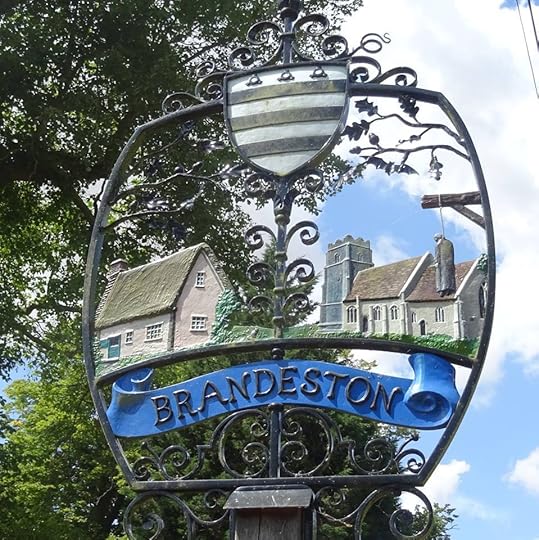
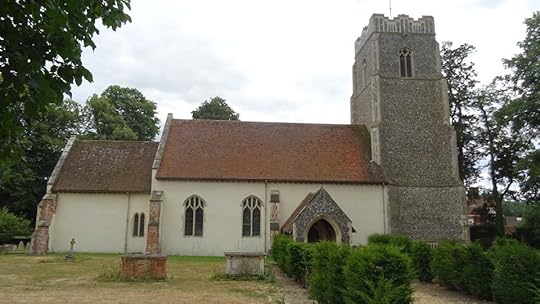
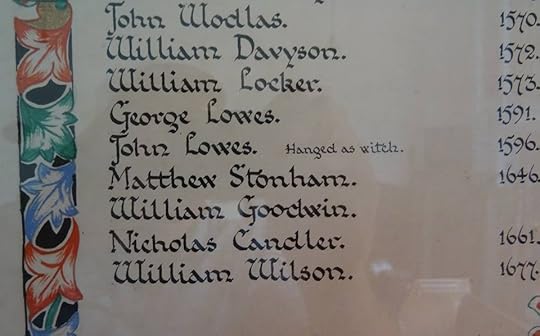
 The plaque above was erected in his church sixty-seven years later by a gentleman who appears to have a firmer grip on reality and common sense than his predecessors. John Lowes is memorably played by Rupert Davies in the film.Hopkins is buried in Mistley churchyard in Essex, but I wasted thirty minutes searching before a clergyman helped me out. He lies there in an unmarked grave and no one knows where.
The plaque above was erected in his church sixty-seven years later by a gentleman who appears to have a firmer grip on reality and common sense than his predecessors. John Lowes is memorably played by Rupert Davies in the film.Hopkins is buried in Mistley churchyard in Essex, but I wasted thirty minutes searching before a clergyman helped me out. He lies there in an unmarked grave and no one knows where.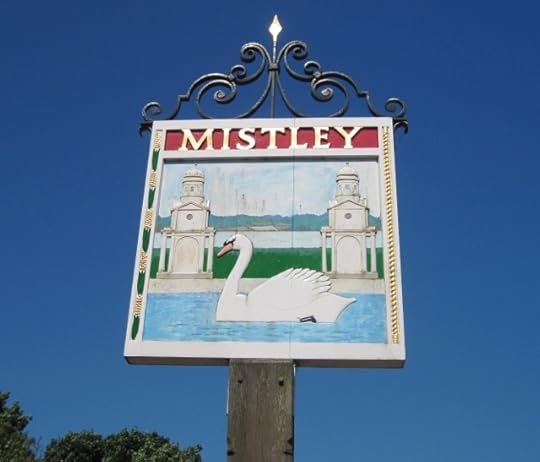
 The filming locations are one aspect of the movie that were very realistic indeed, all of them being shot in the actual villages and countryside where Hopkins carried out his cash-for-murders business.Many killings took place in Lavenham, west of Ipswich, and little has changed in this exquisite little town. The witch burning was filmed in the square there on the very spot where women were executed for real. The Suffolk council no longer allow burning, as the heat and flames would damage vehicle paintwork. These days, health and safety rules ruin everything for religious zealots.
The filming locations are one aspect of the movie that were very realistic indeed, all of them being shot in the actual villages and countryside where Hopkins carried out his cash-for-murders business.Many killings took place in Lavenham, west of Ipswich, and little has changed in this exquisite little town. The witch burning was filmed in the square there on the very spot where women were executed for real. The Suffolk council no longer allow burning, as the heat and flames would damage vehicle paintwork. These days, health and safety rules ruin everything for religious zealots.
 Kentwell Hall is a beautiful old manor house of the Tudor period on the outskirts of Long Melford, Suffolk. The moat and its bridge were used for the witch 'swimming' scenes and the execution of Reverend Lowes. This house is also walking distance from the tiny hamlet of Borley, site of the famous Borley Rectory hauntings.
Kentwell Hall is a beautiful old manor house of the Tudor period on the outskirts of Long Melford, Suffolk. The moat and its bridge were used for the witch 'swimming' scenes and the execution of Reverend Lowes. This house is also walking distance from the tiny hamlet of Borley, site of the famous Borley Rectory hauntings.

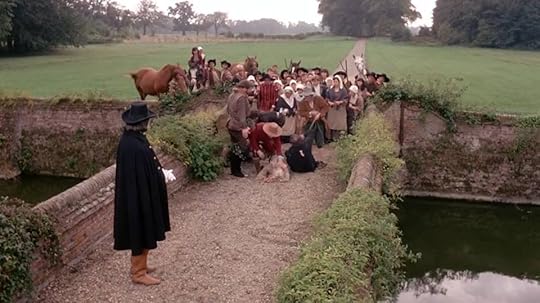


 St. John's church at Rushford, just outside Thetford, stood in for the Brandeston church of John Lowes in the film. His rectory home next door is a college, closed for holidays when I took the shots
St. John's church at Rushford, just outside Thetford, stood in for the Brandeston church of John Lowes in the film. His rectory home next door is a college, closed for holidays when I took the shots



 The finale was flmed inside and outside Orford Castle, again in Suffolk. This is a wonderfully complete medieval keep near Woodbridge on the edge of Rendlesham Forest, famous for its 1980 'British Roswell' UFO activity. The forest, that is, not the castle.
The finale was flmed inside and outside Orford Castle, again in Suffolk. This is a wonderfully complete medieval keep near Woodbridge on the edge of Rendlesham Forest, famous for its 1980 'British Roswell' UFO activity. The forest, that is, not the castle.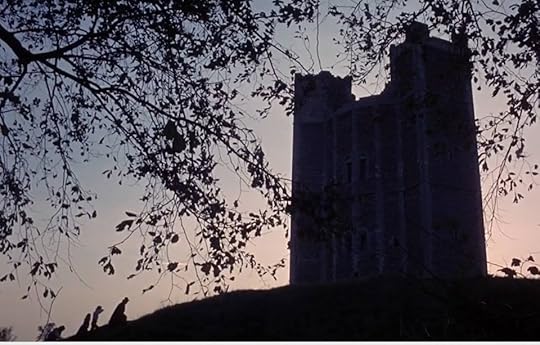
 Inevitably they’re talking about remaking Witchfinder General, just as they remake all films. It was announced at Cannes in 2016 that Nicolas Winding Refn and Rupert Preston would be starting on this in the near future. I live in hope that this new version of Witchfinder General will break the remake curse and turn out to be a really good film, unlike Psycho, Total Recall, Robocop, Get Carter, Poltergeist and the countless others.Leaving aside the lack of imagination in endlessly churning out remakes, perhaps this new version will address the age error in the original and cast a twenty-seven year old. Let's pray they don't cast Nicolas Cage as Hopkins in an attempt to relive the glories of the Wicker Man remake.
Inevitably they’re talking about remaking Witchfinder General, just as they remake all films. It was announced at Cannes in 2016 that Nicolas Winding Refn and Rupert Preston would be starting on this in the near future. I live in hope that this new version of Witchfinder General will break the remake curse and turn out to be a really good film, unlike Psycho, Total Recall, Robocop, Get Carter, Poltergeist and the countless others.Leaving aside the lack of imagination in endlessly churning out remakes, perhaps this new version will address the age error in the original and cast a twenty-seven year old. Let's pray they don't cast Nicolas Cage as Hopkins in an attempt to relive the glories of the Wicker Man remake.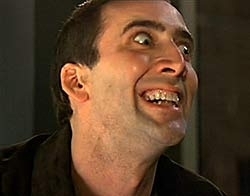
May 26, 2018
FRANK - SEVEN YEARS FAKING THE MONSTER
 I was nominated on Facebook to come up with a book that makes me happy and I’ve opted for a bit of a weird choice: Nessie, Seven Years in Search of The Monster, a 1976 paperback written by Frank Searle and published by Coronet.Along with Harry Price’s the End of Borley Rectory, and Dennis Wheatley’s non-fiction The Devil and All His Works, Frank’s book acted like a gateway drug for the teenage me into the world of the supernatural and a lifelong interest in the subject. Okay, technically the Loch Ness Monster isn’t supernatural (or is it?) and falls instead into cryptozoology, but bear with me.There was a huge supernatural counter culture going on in the late seventies. An occult revival was underway, with all the classic books and grimoires back in print and a host of new titles cashing in on the new age readers. Witchcraft covens were commonplace, along with serious groups who practised ritual magick and, week after week, the Sunday papers were filled with suburban witchcraft wife swappers, Satanists desecrating churchyards, and poltergeists terrorising council houses.Crop circles were appearing in British fields, young people were into ley lines, crystals, Erich von Daniken, stone circles, zodiacs, Atlantis, auras, and visits to Glastonbury Tor. Music, or prog rock, at any rate, was certainly on this wavelength, and cinema events like Close Encounters of the Third Kind boosted an interest in UFOs and alien abductions.
I was nominated on Facebook to come up with a book that makes me happy and I’ve opted for a bit of a weird choice: Nessie, Seven Years in Search of The Monster, a 1976 paperback written by Frank Searle and published by Coronet.Along with Harry Price’s the End of Borley Rectory, and Dennis Wheatley’s non-fiction The Devil and All His Works, Frank’s book acted like a gateway drug for the teenage me into the world of the supernatural and a lifelong interest in the subject. Okay, technically the Loch Ness Monster isn’t supernatural (or is it?) and falls instead into cryptozoology, but bear with me.There was a huge supernatural counter culture going on in the late seventies. An occult revival was underway, with all the classic books and grimoires back in print and a host of new titles cashing in on the new age readers. Witchcraft covens were commonplace, along with serious groups who practised ritual magick and, week after week, the Sunday papers were filled with suburban witchcraft wife swappers, Satanists desecrating churchyards, and poltergeists terrorising council houses.Crop circles were appearing in British fields, young people were into ley lines, crystals, Erich von Daniken, stone circles, zodiacs, Atlantis, auras, and visits to Glastonbury Tor. Music, or prog rock, at any rate, was certainly on this wavelength, and cinema events like Close Encounters of the Third Kind boosted an interest in UFOs and alien abductions. In the USA, Bigfoot was seen more than ever before, probably thanks to the famous Patterson-Gimlin film footage showing the creature strolling through the woods, Amityville was big news and Hollywood films depicted the horrific reality of hauntings, possession, the antichrist, and devil worship. SETI was searching for extra-terrestrial life, and the secret military archives of UFO sightings Project Blue Book could now be read. The magazine Fortean Times appeared in 1976, which reported on strange phenomena and did its best to provide a realistic balanced viewpoint, although most people seemed to prefer the tabloids and the hundreds of paperbacks which lifted the lid on the hollow earth, the hole at the North Pole, the aliens who built the pyramids, Hitler’s occult Reich, etcOf course, all of this ties in with the progression of the modern age – as we learn more and satellites map every inch of the planet, our romantic side yearns for something unknown, mysterious and fantastic - but it was a magical time back then. It really DID feel as if something magically ‘big’ was about to happen – earth ‘energy’ from standing stones would soon be tapped, the reality of ghosts or reincarnation would finally be proven, an alien race would make contact, or America would finally give in and reveal the craft and bodies from the Roswell crash.In the midst of all this there was Loch Ness.
In the USA, Bigfoot was seen more than ever before, probably thanks to the famous Patterson-Gimlin film footage showing the creature strolling through the woods, Amityville was big news and Hollywood films depicted the horrific reality of hauntings, possession, the antichrist, and devil worship. SETI was searching for extra-terrestrial life, and the secret military archives of UFO sightings Project Blue Book could now be read. The magazine Fortean Times appeared in 1976, which reported on strange phenomena and did its best to provide a realistic balanced viewpoint, although most people seemed to prefer the tabloids and the hundreds of paperbacks which lifted the lid on the hollow earth, the hole at the North Pole, the aliens who built the pyramids, Hitler’s occult Reich, etcOf course, all of this ties in with the progression of the modern age – as we learn more and satellites map every inch of the planet, our romantic side yearns for something unknown, mysterious and fantastic - but it was a magical time back then. It really DID feel as if something magically ‘big’ was about to happen – earth ‘energy’ from standing stones would soon be tapped, the reality of ghosts or reincarnation would finally be proven, an alien race would make contact, or America would finally give in and reveal the craft and bodies from the Roswell crash.In the midst of all this there was Loch Ness. Ever since the ‘Surgeon’s Photo’ appeared in 1934, the Loch Ness Monster had been the poster boy for Scottish tourism. There had been many possible sightings and blurred pictures of humps, but now top people were taking the creature seriously and ‘scientific’ photographs of ‘flippers’ appeared on the BBC that showed the animal underwater.
Ever since the ‘Surgeon’s Photo’ appeared in 1934, the Loch Ness Monster had been the poster boy for Scottish tourism. There had been many possible sightings and blurred pictures of humps, but now top people were taking the creature seriously and ‘scientific’ photographs of ‘flippers’ appeared on the BBC that showed the animal underwater.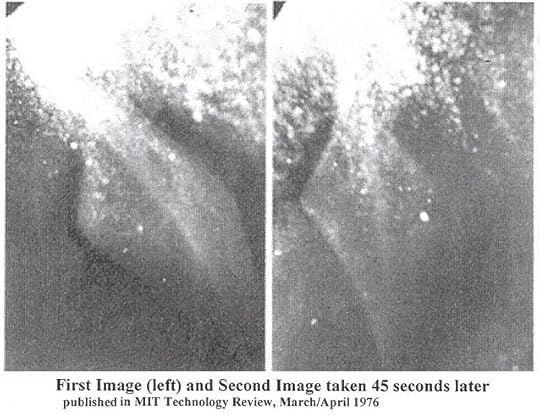
 Eminent naturalist Sir Peter Scott, a man who everyone respected, openly claimed the lake creatures were genuine and spoke of a breeding herd, probably travelling to and from the North Sea through submerged caverns. Nessie was no longer a ‘monster’, but a survivor from the dinosaur age, most probably a plesiosaur. Scott even came up with a scientific name for it - Nessiteras rhombopteryx - and famously painted a pair of the beasts in exactly the same way he painted genuine wild animals.
Eminent naturalist Sir Peter Scott, a man who everyone respected, openly claimed the lake creatures were genuine and spoke of a breeding herd, probably travelling to and from the North Sea through submerged caverns. Nessie was no longer a ‘monster’, but a survivor from the dinosaur age, most probably a plesiosaur. Scott even came up with a scientific name for it - Nessiteras rhombopteryx - and famously painted a pair of the beasts in exactly the same way he painted genuine wild animals. The Loch Ness Phenomena Investigation Bureau had been set up, many serious investigators and academics were searching for the creatures, and now Sir Peter Scott was endorsing them too. It felt like there HAD to be something real in this enormous stretch of deep water.There was, however, another 'investigator' on the banks of the loch, a chubby little man with a cockney accent and a prosthetic foot named Frank Searle, who lived in a small caravan below the village of Foyers. Ex-soldier Frank had spent years taking photographs of the ‘monster’ and in 1976 I read his book.
The Loch Ness Phenomena Investigation Bureau had been set up, many serious investigators and academics were searching for the creatures, and now Sir Peter Scott was endorsing them too. It felt like there HAD to be something real in this enormous stretch of deep water.There was, however, another 'investigator' on the banks of the loch, a chubby little man with a cockney accent and a prosthetic foot named Frank Searle, who lived in a small caravan below the village of Foyers. Ex-soldier Frank had spent years taking photographs of the ‘monster’ and in 1976 I read his book. Nessie, Seven Years in Search of The Monster isn’t particularly well written, but there was something about it which, to the seventeen-year-old me, felt very real. Frank speaks completely openly about his life on the loch and talks of the creatures in the way a Londoner might speak of pigeons in Trafalgar Square. He saw them all the time and you got the impression he was too normal and down-to-earth to make it up. He had scores of photographs of his sightings, but many encounters were when he was off walking without his large camera and telephoto lens.
Nessie, Seven Years in Search of The Monster isn’t particularly well written, but there was something about it which, to the seventeen-year-old me, felt very real. Frank speaks completely openly about his life on the loch and talks of the creatures in the way a Londoner might speak of pigeons in Trafalgar Square. He saw them all the time and you got the impression he was too normal and down-to-earth to make it up. He had scores of photographs of his sightings, but many encounters were when he was off walking without his large camera and telephoto lens.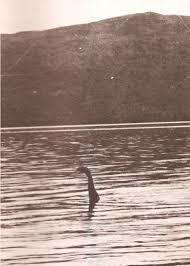 One particular episode amazed me. He was strolling by the loch at dawn and arrived at a stream that fed into it from the hillside. A barb wire fence needed to be climbed before he could jump the water and he was about to do this when he saw an incredible sight. Young plesiosaurs were swimming at the mouth of the stream, ‘treading water’ by paddling with their fins and eating the bits of food that were washed down in the torrent. Frank decided to catch one by diving in and wrestling it out, but he snagged his jeans on the wire and unfortunately startled them. The youngsters spotted him, turned and swam away into the depths before he could free himself. All of this is told in a perfectly natural way, as if he were talking about catching rabbits.He mixes in such stories with tales of swimming in the icy lake every morning, shagging the various young women (mostly American and Australian students) who would inexplicably stay with him in the caravan for weeks at a time, and looking after a Scottish wild cat that he’d managed to tame. He was definitely quite a character.
One particular episode amazed me. He was strolling by the loch at dawn and arrived at a stream that fed into it from the hillside. A barb wire fence needed to be climbed before he could jump the water and he was about to do this when he saw an incredible sight. Young plesiosaurs were swimming at the mouth of the stream, ‘treading water’ by paddling with their fins and eating the bits of food that were washed down in the torrent. Frank decided to catch one by diving in and wrestling it out, but he snagged his jeans on the wire and unfortunately startled them. The youngsters spotted him, turned and swam away into the depths before he could free himself. All of this is told in a perfectly natural way, as if he were talking about catching rabbits.He mixes in such stories with tales of swimming in the icy lake every morning, shagging the various young women (mostly American and Australian students) who would inexplicably stay with him in the caravan for weeks at a time, and looking after a Scottish wild cat that he’d managed to tame. He was definitely quite a character.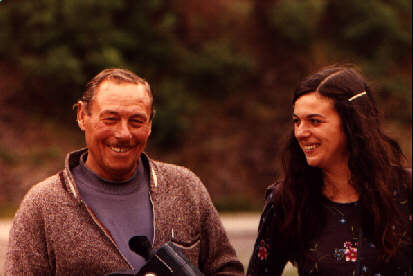 In 1976 at 17 years old I drove up to Loch Ness from Yorkshire with Frank’s book in my pocket. I wanted to meet him and also hoped to see the Scottish birds and wildlife. Another ‘supernatural’ draw was Boleskine House near Foyers, the former home of Aleister Crowley and, at that time, owned by Led Zeppelin guitarist Jimmy Page. Everything fell perfectly into place. On my arrival in the Highlands I saw all the birds in the first two days – crested tit, crossbill, golden eagle, osprey, peregrine, capercailzie, ptarmigan – and as I stood on the empty lane looking at Boleskine, the gates opened and who should drive out, but Page himself. He smiled and nodded as he cruised past.
In 1976 at 17 years old I drove up to Loch Ness from Yorkshire with Frank’s book in my pocket. I wanted to meet him and also hoped to see the Scottish birds and wildlife. Another ‘supernatural’ draw was Boleskine House near Foyers, the former home of Aleister Crowley and, at that time, owned by Led Zeppelin guitarist Jimmy Page. Everything fell perfectly into place. On my arrival in the Highlands I saw all the birds in the first two days – crested tit, crossbill, golden eagle, osprey, peregrine, capercailzie, ptarmigan – and as I stood on the empty lane looking at Boleskine, the gates opened and who should drive out, but Page himself. He smiled and nodded as he cruised past. I walked from here down the road to the water's edge and immediately saw Frank Searle too. This all felt bizarre and strangely magical – the birds, Jimmy Page and the author of the book in my pocket. From Frank’s narrative, I knew how easy it was to see the monsters and I expectantly settled down on a rock to watch the water, genuinely convinced I’d see ‘something’ very soon.I didn’t, as it turned out, although Frank assured me I'd been unlucky. I later discovered I’d been incredibly fortunate to spot Page; he hardly ever visited Boleskine, despite Frank claiming he dined with him all the time. Actually Frank claimed a lot of things.
I walked from here down the road to the water's edge and immediately saw Frank Searle too. This all felt bizarre and strangely magical – the birds, Jimmy Page and the author of the book in my pocket. From Frank’s narrative, I knew how easy it was to see the monsters and I expectantly settled down on a rock to watch the water, genuinely convinced I’d see ‘something’ very soon.I didn’t, as it turned out, although Frank assured me I'd been unlucky. I later discovered I’d been incredibly fortunate to spot Page; he hardly ever visited Boleskine, despite Frank claiming he dined with him all the time. Actually Frank claimed a lot of things. By his caravan, Frank had constructed a large homemade shelter of wood and corrugated plastic that rattled deafeningly in even the gentlest breeze - his Loch Ness Monster Exhibition. Hundreds of photographs covered the walls with autographed pictures of famous people wishing him well on his cryptozoology crusade. The only ones I now remember were Neil Armstrong (I saw the surface of the moon, but I really envy the things Frank has seen) and Tom Baker who’d filmed a Doctor Who story up there. I now wonder if these were fake or not, because most things about Frank turned out to be somewhat iffy.
By his caravan, Frank had constructed a large homemade shelter of wood and corrugated plastic that rattled deafeningly in even the gentlest breeze - his Loch Ness Monster Exhibition. Hundreds of photographs covered the walls with autographed pictures of famous people wishing him well on his cryptozoology crusade. The only ones I now remember were Neil Armstrong (I saw the surface of the moon, but I really envy the things Frank has seen) and Tom Baker who’d filmed a Doctor Who story up there. I now wonder if these were fake or not, because most things about Frank turned out to be somewhat iffy. I spoke with him for hours on that first visit (he signed my book) and on several occasions over the next few years. He always came across as an eccentric and genuinely nice man, although not everyone shared this view. One visitor, I’ve since read about on the internet, tells of how he introduced himself only to be completely blanked as Frank headed for a young blonde tourist in a low-cut top. After leering at her breasts, he asked if she liked his T shirt. The shirt had a cartoon of a hiccupping drunken cat with a bottle, and the caption: I love ‘tight’ pussies.The problem was that, for over a decade, Frank had effectively been the only investigator on the loch. He’d become quite famous and made quite a bit of cash from his pictures, the book I’d bought and donations from his many fans. Now there were other, far more ‘reliable’ investigations setting up, his nose was pushed out, and experts had finally begun to look at his photos.
I spoke with him for hours on that first visit (he signed my book) and on several occasions over the next few years. He always came across as an eccentric and genuinely nice man, although not everyone shared this view. One visitor, I’ve since read about on the internet, tells of how he introduced himself only to be completely blanked as Frank headed for a young blonde tourist in a low-cut top. After leering at her breasts, he asked if she liked his T shirt. The shirt had a cartoon of a hiccupping drunken cat with a bottle, and the caption: I love ‘tight’ pussies.The problem was that, for over a decade, Frank had effectively been the only investigator on the loch. He’d become quite famous and made quite a bit of cash from his pictures, the book I’d bought and donations from his many fans. Now there were other, far more ‘reliable’ investigations setting up, his nose was pushed out, and experts had finally begun to look at his photos. All were found to be fake, and most of them very poor fakes – one was a postcard of a dinosaur that he’d cut out and crudely pasted onto a picture of the loch. He’d also been in talks with a London publisher and was about to bring out a second book, a sequel to the one I’d read, and when this was cancelled, he blamed his rivals at the Loch Ness phenomena Investigation Bureau, especially their leader, the very reputable Adrian Shine whom he’d openly libelled in the text.Frank may, or may not, have painted six-feet high graffiti on the walls of Urquhart castle claiming Shine to be a conman and then later, er firebombing the boats owned by the bureau with Molotov cocktails. The police had a lengthy chat with him, but although no charges were brought, he vanished from the loch in 1983 and, for many years, from history. Some claimed he’d crossed the Glasgow underworld and was dead at the bottom of the lake, some had seen him illegally metal detecting on Scottish battlefields, some said he was lecturing in America, and some said he was hunting for treasure in Cornwall. In 2005 the film maker, Andrew Tullis decided to bring out a documentary about his eccentric life and managed to track him down. He was eventually found in a Fleetwood bedsit, but incredibly just days after he’d died there at 83.One of the best epitaphs I read was by Gordon Rutter, head of the Edinburgh Fortean Society who told me: I had a signed book by Frank Searle, but the signature turned out to be fake. Brilliant.Every time I see Nessie, Seven Years in Search of the Monster, or read chapters, I’m instantly transported back to those more innocent ‘new age’ days in the late seventies. It’s odd, but knowing now that the entire book is bullshit doesn’t detract from the feeling. The thing that destroys the entire period for me was when I realised that Sir Peter Scott’s scientific name for the creatures, Nessiteras rhombopteryx, is an anagram of Monster hoax by Sir Peter S.
All were found to be fake, and most of them very poor fakes – one was a postcard of a dinosaur that he’d cut out and crudely pasted onto a picture of the loch. He’d also been in talks with a London publisher and was about to bring out a second book, a sequel to the one I’d read, and when this was cancelled, he blamed his rivals at the Loch Ness phenomena Investigation Bureau, especially their leader, the very reputable Adrian Shine whom he’d openly libelled in the text.Frank may, or may not, have painted six-feet high graffiti on the walls of Urquhart castle claiming Shine to be a conman and then later, er firebombing the boats owned by the bureau with Molotov cocktails. The police had a lengthy chat with him, but although no charges were brought, he vanished from the loch in 1983 and, for many years, from history. Some claimed he’d crossed the Glasgow underworld and was dead at the bottom of the lake, some had seen him illegally metal detecting on Scottish battlefields, some said he was lecturing in America, and some said he was hunting for treasure in Cornwall. In 2005 the film maker, Andrew Tullis decided to bring out a documentary about his eccentric life and managed to track him down. He was eventually found in a Fleetwood bedsit, but incredibly just days after he’d died there at 83.One of the best epitaphs I read was by Gordon Rutter, head of the Edinburgh Fortean Society who told me: I had a signed book by Frank Searle, but the signature turned out to be fake. Brilliant.Every time I see Nessie, Seven Years in Search of the Monster, or read chapters, I’m instantly transported back to those more innocent ‘new age’ days in the late seventies. It’s odd, but knowing now that the entire book is bullshit doesn’t detract from the feeling. The thing that destroys the entire period for me was when I realised that Sir Peter Scott’s scientific name for the creatures, Nessiteras rhombopteryx, is an anagram of Monster hoax by Sir Peter S.
May 12, 2018
WHATEVER POSSESSED YOU TO GO THERE?

 In the 45 years since the Exorcist opened in cinemas very little has changed in the leafy streets of Georgetown, Washington. It’s a lovely little suburb of attractive houses and buildings, art galleries, vegan bistros, and craft beers. Apart from the newer streetlamps, modern cars and a lack of Mesopotamian demons, everything is pretty much as it was back in 1973.
In the 45 years since the Exorcist opened in cinemas very little has changed in the leafy streets of Georgetown, Washington. It’s a lovely little suburb of attractive houses and buildings, art galleries, vegan bistros, and craft beers. Apart from the newer streetlamps, modern cars and a lack of Mesopotamian demons, everything is pretty much as it was back in 1973. It isn’t often that the locations in a work of fiction are in the exact place you expect them to be. In the Walking Dead, for example, what appears to be a ten-minute stroll from Alexandria is actually thirty miles away. What seems to be over two-hundred miles away is literally next door to Alexandria and cleverly kept out of camera shot.Film makers aren’t needlessly constrained by reality and all of them take huge topographical liberties like this. They may like the look of a pub in Manchester and a restaurant in York. In the finished movie, the actor will leave the pub, walk around a street corner and seamlessly enter the restaurant.It’s enough to make your head spin. Ahem!
It isn’t often that the locations in a work of fiction are in the exact place you expect them to be. In the Walking Dead, for example, what appears to be a ten-minute stroll from Alexandria is actually thirty miles away. What seems to be over two-hundred miles away is literally next door to Alexandria and cleverly kept out of camera shot.Film makers aren’t needlessly constrained by reality and all of them take huge topographical liberties like this. They may like the look of a pub in Manchester and a restaurant in York. In the finished movie, the actor will leave the pub, walk around a street corner and seamlessly enter the restaurant.It’s enough to make your head spin. Ahem!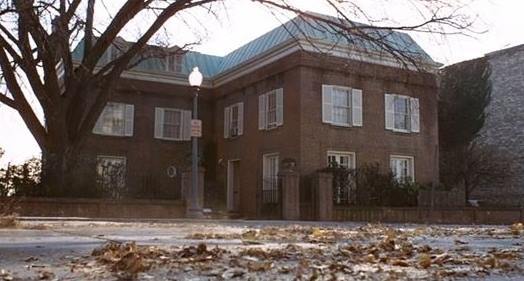
 With the Exorcist, William Friedkin could have found a house to film in, a flight of steps in another city and a university campus five states away. Simple editing would have brought everything together, but for once there was no need.Author William Peter Blatty set his novel in a genuine location and plotted the story around real places - everything in the film is as he described. The MacNeil house in the novel is right where it’s supposed to be – number 1600 Prospect Street - and so are the precipitous steps beside it. The only necessary change was a fake extension, containing Reagan’s bedroom, that had to be added to the left elevation (above). This was constructed to position her window over the steps and make it more believable that two people could fall from there.The house shutters and brick gateposts are now painted black and black wooden fencing has replaced the railingsThe campus of the Jesuit university is around the corner from the house, the desecrated church – Dahlgren Chapel - is part of this, and pretty much everything we see on screen can be found in an area of Georgetown that covers about a quarter of a mile. All apart from Nineveh in the opening scenes - that’s quite a bit further away and religious people with guns make it difficult to visit and photograph.
With the Exorcist, William Friedkin could have found a house to film in, a flight of steps in another city and a university campus five states away. Simple editing would have brought everything together, but for once there was no need.Author William Peter Blatty set his novel in a genuine location and plotted the story around real places - everything in the film is as he described. The MacNeil house in the novel is right where it’s supposed to be – number 1600 Prospect Street - and so are the precipitous steps beside it. The only necessary change was a fake extension, containing Reagan’s bedroom, that had to be added to the left elevation (above). This was constructed to position her window over the steps and make it more believable that two people could fall from there.The house shutters and brick gateposts are now painted black and black wooden fencing has replaced the railingsThe campus of the Jesuit university is around the corner from the house, the desecrated church – Dahlgren Chapel - is part of this, and pretty much everything we see on screen can be found in an area of Georgetown that covers about a quarter of a mile. All apart from Nineveh in the opening scenes - that’s quite a bit further away and religious people with guns make it difficult to visit and photograph. The steep steps lead down from Prospect Street to Canal Road.
The steep steps lead down from Prospect Street to Canal Road.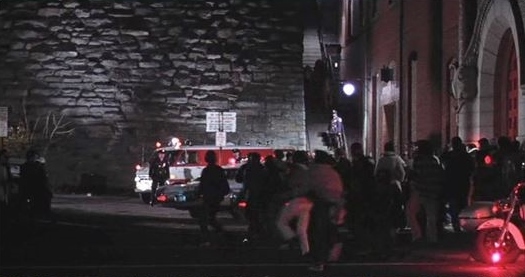
 These used to be known as the Hitchcock Steps, but since 1973 the name has changed. It isn’t difficult to guess the new name and a wall plaque helps identify them.
These used to be known as the Hitchcock Steps, but since 1973 the name has changed. It isn’t difficult to guess the new name and a wall plaque helps identify them.
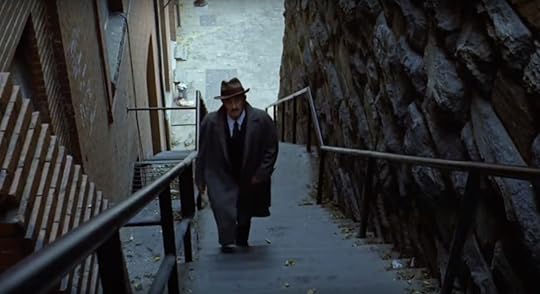
 One of the entrance / exits to the university campus on 37th Street. The street lighting is now different and a few demonic wheelie bins have mysteriously appeared.
One of the entrance / exits to the university campus on 37th Street. The street lighting is now different and a few demonic wheelie bins have mysteriously appeared.
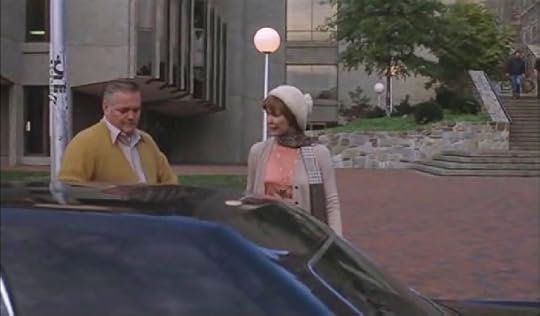
 Ellen Burstyn leaves the campus film set within a film set and walks home along 36th Street, just after turning off P Street. It’s virtually impossible to stroll along here without whistling Tubular Bells.
Ellen Burstyn leaves the campus film set within a film set and walks home along 36th Street, just after turning off P Street. It’s virtually impossible to stroll along here without whistling Tubular Bells.

 The bridge where Chris meets Karras is below the house, down a footpath off M Street, it’s a footbridge over the Chesapeake & Ohio Canal. Instead of anxious women and priests, the bridge and pathways are now home to joggers with wires dangling from their ears.
The bridge where Chris meets Karras is below the house, down a footpath off M Street, it’s a footbridge over the Chesapeake & Ohio Canal. Instead of anxious women and priests, the bridge and pathways are now home to joggers with wires dangling from their ears.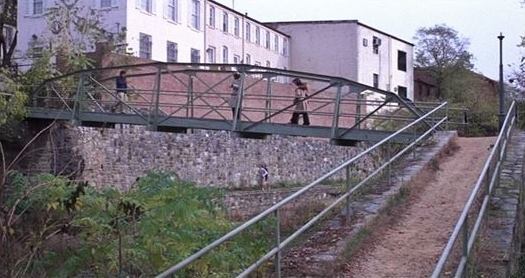
 The Catholic university of Georgetown is owned by the Jesuits and they allowed filming there and in their churches, probably because, despite all the demonology, blaspheming and jilling off with a crucifix, the priests are the heroes of the story and two get a martyr’s death.
The Catholic university of Georgetown is owned by the Jesuits and they allowed filming there and in their churches, probably because, despite all the demonology, blaspheming and jilling off with a crucifix, the priests are the heroes of the story and two get a martyr’s death. Today, without Jack MacGowran's fictional film set...
Today, without Jack MacGowran's fictional film set... Karras leaving the film set
Karras leaving the film set
 The campus where Karras walked today...
The campus where Karras walked today... As I say, the Catholic church allowed one of the most infamous horror movies of all time to be filmed on their property, probably because of the message - good beats the devil.After countless horror films where good (often in the shape of Peter Cushing) invariably triumphed over evil, a new cinema trend was emerging back then. Practically unthinkable before, film makers were now starting to unnerve their audiences by having the devil craftily win in the end: Rosemary’s Baby, To the Devil a Daughter, Race With the Devil, the Omen, the Wicker Man – the list goes on. In the Exorcist, the Catholic priests beat the demon Pazuzu and everyone breathes a sigh of relief.Or at least they did until someone decided to ruin things by making Exorcist 2.The steps are still an absolute deathtrap and something needs to be done about them...
As I say, the Catholic church allowed one of the most infamous horror movies of all time to be filmed on their property, probably because of the message - good beats the devil.After countless horror films where good (often in the shape of Peter Cushing) invariably triumphed over evil, a new cinema trend was emerging back then. Practically unthinkable before, film makers were now starting to unnerve their audiences by having the devil craftily win in the end: Rosemary’s Baby, To the Devil a Daughter, Race With the Devil, the Omen, the Wicker Man – the list goes on. In the Exorcist, the Catholic priests beat the demon Pazuzu and everyone breathes a sigh of relief.Or at least they did until someone decided to ruin things by making Exorcist 2.The steps are still an absolute deathtrap and something needs to be done about them... I'll finish this with a shot of Lt. Kinderman investigating my substantial insurance claim...
I'll finish this with a shot of Lt. Kinderman investigating my substantial insurance claim...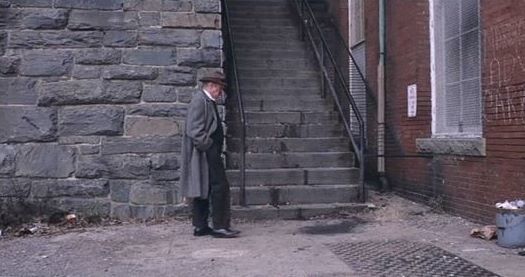
March 20, 2018
THE BLACK MONK OF PONTEFRACT
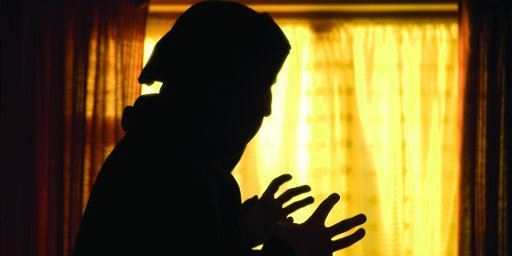 Along with Borley and the Enfield poltergeist, the Black Monk of Pontefract (can we still say ‘black’ monk these days?) is arguably one of Britain’s most famous ‘modern’ ghost stories. Originally a small news item followed on and off by the local papers – firstly the Pontefract and Castleford Express and then the Yorkshire Post - much of the fame is down to Colin Wilson, the well-known author of works such as The Outsider and The Occult. He travelled to Yorkshire to investigate, which resulted in Poltergeist, the 1981 book that became a ‘must read’ for anyone interested in psychical research.
Along with Borley and the Enfield poltergeist, the Black Monk of Pontefract (can we still say ‘black’ monk these days?) is arguably one of Britain’s most famous ‘modern’ ghost stories. Originally a small news item followed on and off by the local papers – firstly the Pontefract and Castleford Express and then the Yorkshire Post - much of the fame is down to Colin Wilson, the well-known author of works such as The Outsider and The Occult. He travelled to Yorkshire to investigate, which resulted in Poltergeist, the 1981 book that became a ‘must read’ for anyone interested in psychical research.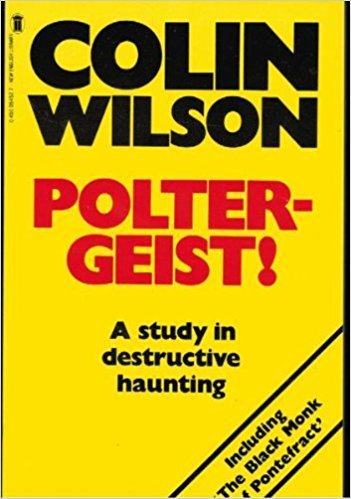 The setting for this story of robed figures and paranormal activity is the council estate of Chequerfield on the southern edge of Pontefract. The nondescript semi, 30 East Drive, has been called the British Amityville, which is a little harsh because many believe this haunting to be genuine.
The setting for this story of robed figures and paranormal activity is the council estate of Chequerfield on the southern edge of Pontefract. The nondescript semi, 30 East Drive, has been called the British Amityville, which is a little harsh because many believe this haunting to be genuine. The black monk features briefly in the new Bernie Quist mystery I’m writing and I’ve been doing a bit of research.The Pritchard family moved to East Drive in 1966 – Jean and Joe, and their children, 15 year old Philip, and Diane. Diane was 12 and seemingly the focus for the paranormal activity that began almost immediately and continued through the late 60s and into the 70s.All the classic poltergeist phenomena was experienced in the semi-detached house: tapping, bangs, lights being turned off and on, sudden temperature drops, foul smells and objects being levitated and thrown. Added to this, pools of water would appear, the origin of which confounded plumbers, clouds of dust fell from ceilings, and green foam poured from taps and the toilet. Heavy furniture was knocked about and pictures on the walls were slashed, weird farmyard noises sounded inside the house, and unnerving heavy breathing was often heard. I’ve passed the house many times and spoken to locals. They tell of the dark early mornings back then, when intrigued people would pause on their way to work to watch lights flashing on and off.Jean Pritchard reading Colin Wilson's book outside the house.
The black monk features briefly in the new Bernie Quist mystery I’m writing and I’ve been doing a bit of research.The Pritchard family moved to East Drive in 1966 – Jean and Joe, and their children, 15 year old Philip, and Diane. Diane was 12 and seemingly the focus for the paranormal activity that began almost immediately and continued through the late 60s and into the 70s.All the classic poltergeist phenomena was experienced in the semi-detached house: tapping, bangs, lights being turned off and on, sudden temperature drops, foul smells and objects being levitated and thrown. Added to this, pools of water would appear, the origin of which confounded plumbers, clouds of dust fell from ceilings, and green foam poured from taps and the toilet. Heavy furniture was knocked about and pictures on the walls were slashed, weird farmyard noises sounded inside the house, and unnerving heavy breathing was often heard. I’ve passed the house many times and spoken to locals. They tell of the dark early mornings back then, when intrigued people would pause on their way to work to watch lights flashing on and off.Jean Pritchard reading Colin Wilson's book outside the house. The worst, and most celebrated, aspect of the haunting was the mysterious black-robed figure which often appeared in 30 East Drive. Many saw the apparition and were present during the poltergeist activity, but Diane was the central witness and would sometimes receive bruises and scratches. On one occasion she was grabbed tightly by the throat, and dragged upstairs by her hair.I have to admit, I always wonder why any sane person would stay in a place with such terrors, but apparently the ‘house-proud’ Jean Pritchard refused to be forced out by a ghost (even if it meant her daughter’s death, presumably). Jean woke one night to find the monk glaring down as it floated over her bed which, personally speaking, would have had me checking into the nearest Travelodge within twelve minutes.
The worst, and most celebrated, aspect of the haunting was the mysterious black-robed figure which often appeared in 30 East Drive. Many saw the apparition and were present during the poltergeist activity, but Diane was the central witness and would sometimes receive bruises and scratches. On one occasion she was grabbed tightly by the throat, and dragged upstairs by her hair.I have to admit, I always wonder why any sane person would stay in a place with such terrors, but apparently the ‘house-proud’ Jean Pritchard refused to be forced out by a ghost (even if it meant her daughter’s death, presumably). Jean woke one night to find the monk glaring down as it floated over her bed which, personally speaking, would have had me checking into the nearest Travelodge within twelve minutes. Despite the horror and violence, and pretty much like every other haunted family at the time, they gave their ghost the friendly name ‘Fred’. Writer Tom Cuniff, however, somehow managed to identify the dark apparition as a 16th century monk who was hanged for the rape and murder of a girl about Diane’s age. This, he said, was the reason the monk was fixated on the youngest Pritchard child. Also, the house may, or may not, have been built next to the site of the gallows where the monk was executed.
Despite the horror and violence, and pretty much like every other haunted family at the time, they gave their ghost the friendly name ‘Fred’. Writer Tom Cuniff, however, somehow managed to identify the dark apparition as a 16th century monk who was hanged for the rape and murder of a girl about Diane’s age. This, he said, was the reason the monk was fixated on the youngest Pritchard child. Also, the house may, or may not, have been built next to the site of the gallows where the monk was executed.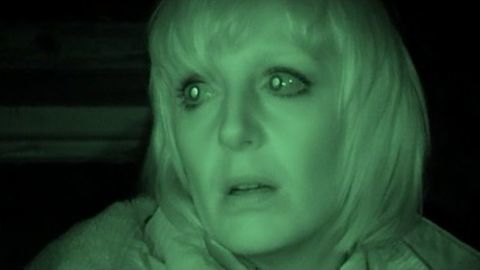 On Halloween 2015 the Most Haunted television team cemented their scientific parapsychologist image by televising a special live programme from East Drive with Lily Savage herself, Paul O’Grady and ‘celebrity’ Rylan joining the screaming Yvette Fielding.
On Halloween 2015 the Most Haunted television team cemented their scientific parapsychologist image by televising a special live programme from East Drive with Lily Savage herself, Paul O’Grady and ‘celebrity’ Rylan joining the screaming Yvette Fielding. During the ‘investigation’ Yvette and Paul huddled whimpering in the ‘coal hole’, the pitch-black room where heaps of coal were stored before gas arrived on the Chequerfield estate. Fans of the show just can’t get enough of Yvette’s frightened green face on night-vision film. The coal store was the scene of terrifying encounters with the monk, but unfortunately nothing was seen this night.
During the ‘investigation’ Yvette and Paul huddled whimpering in the ‘coal hole’, the pitch-black room where heaps of coal were stored before gas arrived on the Chequerfield estate. Fans of the show just can’t get enough of Yvette’s frightened green face on night-vision film. The coal store was the scene of terrifying encounters with the monk, but unfortunately nothing was seen this night.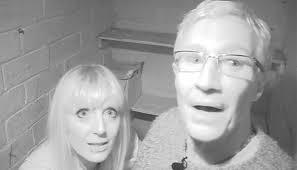 The 2012 film When the Lights Went Out was loosely based on the Pontefract hauntings, with names changed, but most of the story intact including the spectral monk. An atmospheric and very effective film by Pat Holden, the story is brought forward from 1966 to 1974 to include the power cuts of the title.
The 2012 film When the Lights Went Out was loosely based on the Pontefract hauntings, with names changed, but most of the story intact including the spectral monk. An atmospheric and very effective film by Pat Holden, the story is brought forward from 1966 to 1974 to include the power cuts of the title.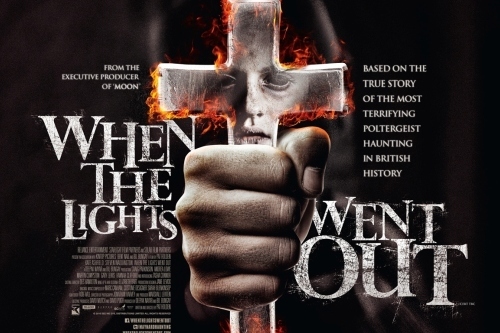
 As well as being director, Holden has a rather large link to the story in that Jean Pritchard was his aunt and, as a child, he experienced some of the things he later brought to the screen. The film stars, amongst others, Steven Waddington, the brilliant Craig Parkinson (Line of Duty’s DI Cottan) and a marvellous find in the young actress Tasha Connor, below on the poster.
As well as being director, Holden has a rather large link to the story in that Jean Pritchard was his aunt and, as a child, he experienced some of the things he later brought to the screen. The film stars, amongst others, Steven Waddington, the brilliant Craig Parkinson (Line of Duty’s DI Cottan) and a marvellous find in the young actress Tasha Connor, below on the poster. Look on Google Earth and you’ll find a marker on the house with the words Pontefract Poltergeist. I checked the locations of other famous hauntings – Enfield, Borley and er, Ocean Drive, Amityville – but Yorkshire has the only ghost marker.
Look on Google Earth and you’ll find a marker on the house with the words Pontefract Poltergeist. I checked the locations of other famous hauntings – Enfield, Borley and er, Ocean Drive, Amityville – but Yorkshire has the only ghost marker. I felt quite patriotic about this until I realised 30 East Drive is now a business. Bill Bungay, the producer of When the Lights Went Out, bought the house quite cheaply after filming (it was up for £75,000) and began allowing ghost hunters to spend the night on the premises for a fee. Apparently, the phenomena, which ceased after the Pritchards left, has started again. Neighbours and other locals claim this is ‘probably due to the film’.Here's a recent picture taken in the house of a 'ghost monk's arm' reaching around a corner and holding rosary beads.
I felt quite patriotic about this until I realised 30 East Drive is now a business. Bill Bungay, the producer of When the Lights Went Out, bought the house quite cheaply after filming (it was up for £75,000) and began allowing ghost hunters to spend the night on the premises for a fee. Apparently, the phenomena, which ceased after the Pritchards left, has started again. Neighbours and other locals claim this is ‘probably due to the film’.Here's a recent picture taken in the house of a 'ghost monk's arm' reaching around a corner and holding rosary beads. Ouija boards are inexplicably banned from the property during these overnight ghost vigils, but so are exorcisms, which is far more understandable for a business that trades in spirit sightings. It would be similar to taking myxomatosis to a rabbit farm.
Ouija boards are inexplicably banned from the property during these overnight ghost vigils, but so are exorcisms, which is far more understandable for a business that trades in spirit sightings. It would be similar to taking myxomatosis to a rabbit farm.
January 23, 2018
HERE'S A GOOD TIP...
 Like all baby boys at the time, Jesus was ritually mutilated at eight days old by having the end hacked off his todger. Unbelievably, this child abuse still legally continues today with no sign of intervention from the authorities. The foreskin of Christ was preserved with oils and herbs by an old Hebrew woman and stored in an alabaster box, but then it vanished from ‘history’ until the Middle Ages.It surfaced when Charlemagne gave it to Pope Leo III as a 'thank you' for crowning him Emperor.
Like all baby boys at the time, Jesus was ritually mutilated at eight days old by having the end hacked off his todger. Unbelievably, this child abuse still legally continues today with no sign of intervention from the authorities. The foreskin of Christ was preserved with oils and herbs by an old Hebrew woman and stored in an alabaster box, but then it vanished from ‘history’ until the Middle Ages.It surfaced when Charlemagne gave it to Pope Leo III as a 'thank you' for crowning him Emperor. Apparently it had been a wedding present to Charlemagne from the Empress Irene, quite a piss-poor gift compared to a dinner service or toaster. It was kept in the Pope’s Sancta Sanctorum until Rome was sacked in 1527 and a German soldier decided to steal this scrap of shrivelled skin, as opposed to gold and jewels. He took it to the stunning hilltop town of Calcata in Italy where his luck ran out and he was captured and imprisoned.
Apparently it had been a wedding present to Charlemagne from the Empress Irene, quite a piss-poor gift compared to a dinner service or toaster. It was kept in the Pope’s Sancta Sanctorum until Rome was sacked in 1527 and a German soldier decided to steal this scrap of shrivelled skin, as opposed to gold and jewels. He took it to the stunning hilltop town of Calcata in Italy where his luck ran out and he was captured and imprisoned. The soldier hid the foreskin in his cell where it remained until it was found thirty years later. From then on, the relic was kept and venerated by the proud people of Calcata, and it was responsible for several colourful urban myths, or ‘miracles’ as the Catholics refer to them. These miracles were enough to have the Catholic Church approve its authenticity over the dozens of other foreskins floating around that supposedly came from Jesus. The Calcata foreskin was definitely the ONE.
The soldier hid the foreskin in his cell where it remained until it was found thirty years later. From then on, the relic was kept and venerated by the proud people of Calcata, and it was responsible for several colourful urban myths, or ‘miracles’ as the Catholics refer to them. These miracles were enough to have the Catholic Church approve its authenticity over the dozens of other foreskins floating around that supposedly came from Jesus. The Calcata foreskin was definitely the ONE. In 1900, the Vatican was sick of the celebration of the foreskin and the Pope issued a warning that anyone who so much as mentioned it would be excommunicated. The good folk of Calcata seemingly didn’t give a toss and continued to loudly parade it through the streets every year on the Feast of the Circumcision, a phrase which is a little repulsive.Unfortunately for Calcata, everything ended in 1983 when the skin vanished once again and, supposedly, no one has seen it since. Many believe it was stolen by agents of the Vatican in order to get people to finally shut up going on about it. Why the foreskin went from being a top Catholic treasure to a being bit of an embarrassment to them is a mystery.
In 1900, the Vatican was sick of the celebration of the foreskin and the Pope issued a warning that anyone who so much as mentioned it would be excommunicated. The good folk of Calcata seemingly didn’t give a toss and continued to loudly parade it through the streets every year on the Feast of the Circumcision, a phrase which is a little repulsive.Unfortunately for Calcata, everything ended in 1983 when the skin vanished once again and, supposedly, no one has seen it since. Many believe it was stolen by agents of the Vatican in order to get people to finally shut up going on about it. Why the foreskin went from being a top Catholic treasure to a being bit of an embarrassment to them is a mystery.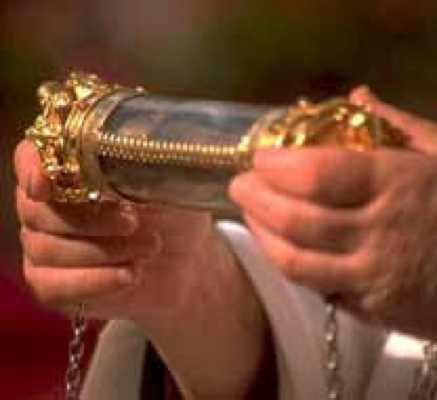 This is definitely what Indiana Jones or Robert Langdon should be searching for in the next film. Maybe a joint venture similar to the Batman/Superman movie?
This is definitely what Indiana Jones or Robert Langdon should be searching for in the next film. Maybe a joint venture similar to the Batman/Superman movie?



